1996
Take of right, humpback, and fin whales in various Atlantic coast trap and gillnet fisheries for lobster, crabs, conchs/whelks, groundfish, monkfish, sharks, hagfish, and other finfish.
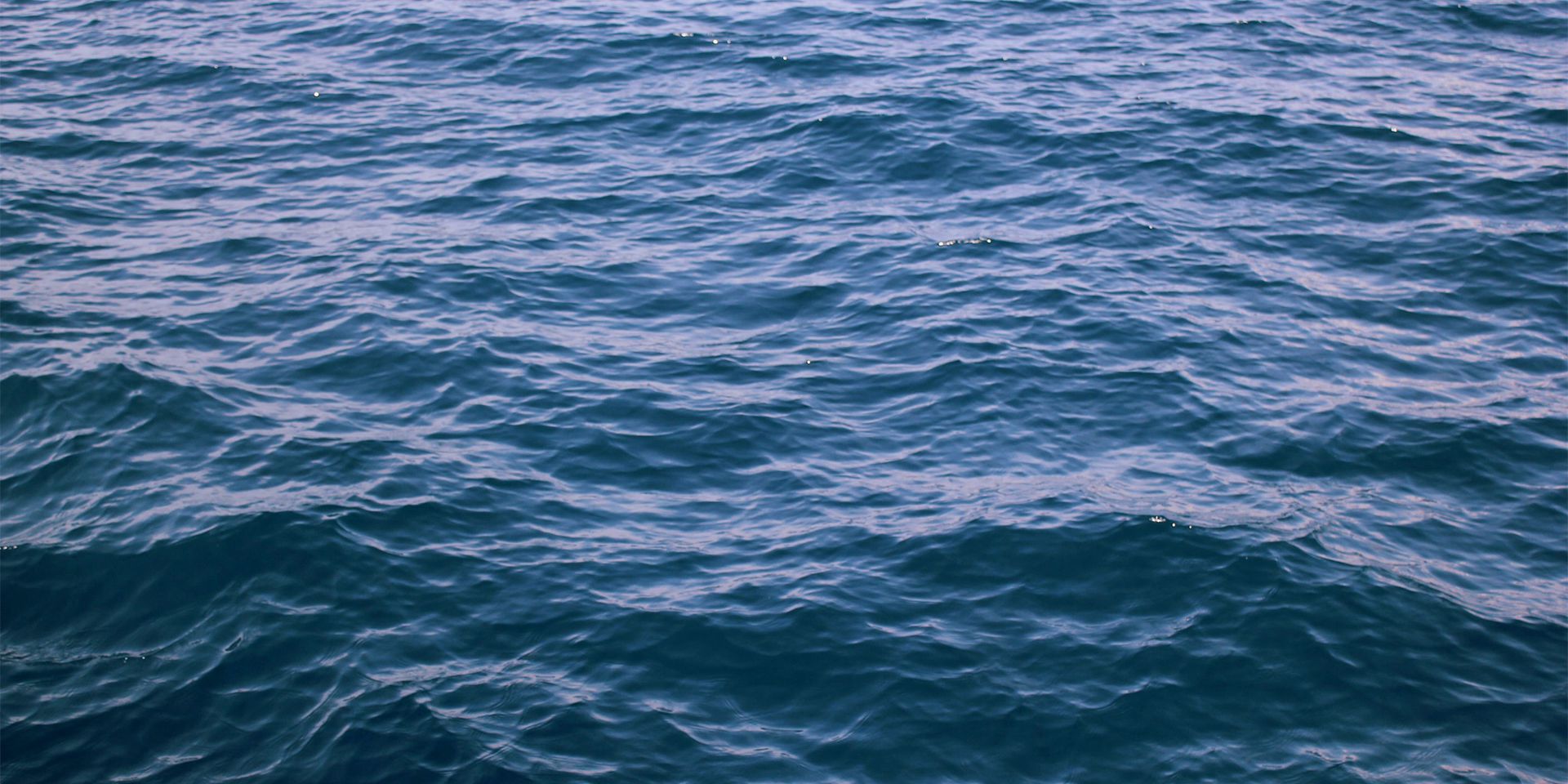
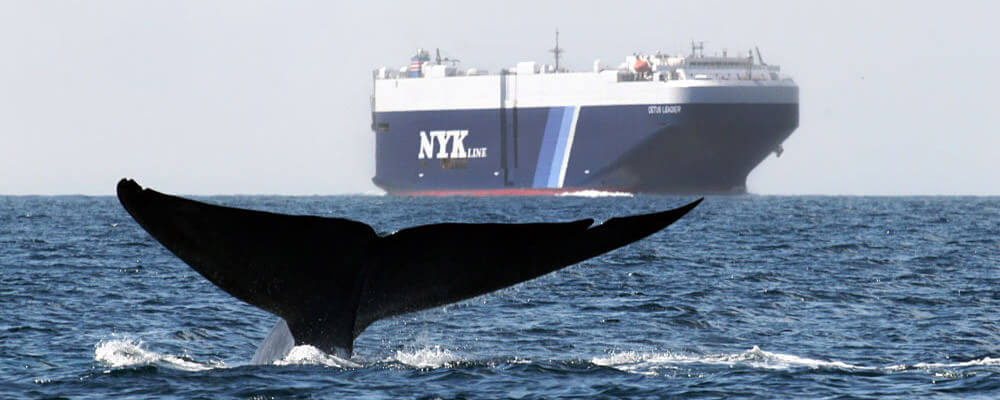
Blue whale diving near container ship (John Calambokidis, Cascadia Research, via NOAA)
Large whales are vulnerable to being struck and killed or injured by vessels of all sizes. This is an issue of great concern to the National Oceanic and Atmospheric Administration (NOAA), Congress, the media, and the public, especially when it involves endangered whale populations or impacts the operations or safety of mariners. It is important to understand how much of a threat vessel strike is to large whales and what options can effectively reduce the risk of injury and death.
Whale behavior can increase their risk of vessel strike
People often wonder why whales don’t simply move out of the way when vessels approach. High levels of ocean noise and the fast speed of some vessels may complicate vessel avoidance. The biology and behavior of each whale species can also affect its risk of vessel strike, highlighting the need for speed or routing measures that specifically address the needs of vulnerable species in particular regions.
North Atlantic right whales
North Atlantic right whales are harder for mariners to see than most whale species because they do not have a dorsal fin. Mothers and calves spend a lot of time resting and nursing near the surface, increasing their vulnerability to vessel strike. Right whales feeding just below or at the surface are also at a higher risk of vessel strike.
Rice’s whales
Tagging studies have shown that Rice’s whales spend up to 88% of their time at night within 15 meters of the surface. This behavior puts them at a high risk of being struck at night.
Even though whales are large animals, collisions with boats of all sizes can injure and kill them. In the U.S., vessel strike has been identified as a major threat to many large whale species, including North Atlantic and North Pacific right whales, Rice’s whales, blue whales, humpback whales, gray whales, and fin whales.
Information regarding vessel strikes is obtained when mariners or others observe and report a vessel strike event, a floating or beached whale carcass, or an injured whale. Vessel strikes can kill or injure large whales in two ways. Blunt force trauma, which occurs when the whale is hit by the bow or hull of a ship, is often not apparent on intact stranded whales but is detected by internal examination after death. Signs of blunt force trauma include bruising and hemorrhage in the blubber and muscle and broken bones. If a carcass is too decomposed, scientists may not be able to detect signs that a vessel strike occurred. Acute trauma, when a whale is hit by the propeller of a vessel, often results in a series of parallel lacerations that can usually be seen by external examination of a carcass or live whale, as seen in the photo below. Analysis of the wounds can help estimate the size of the vessel that was involved in the collision.
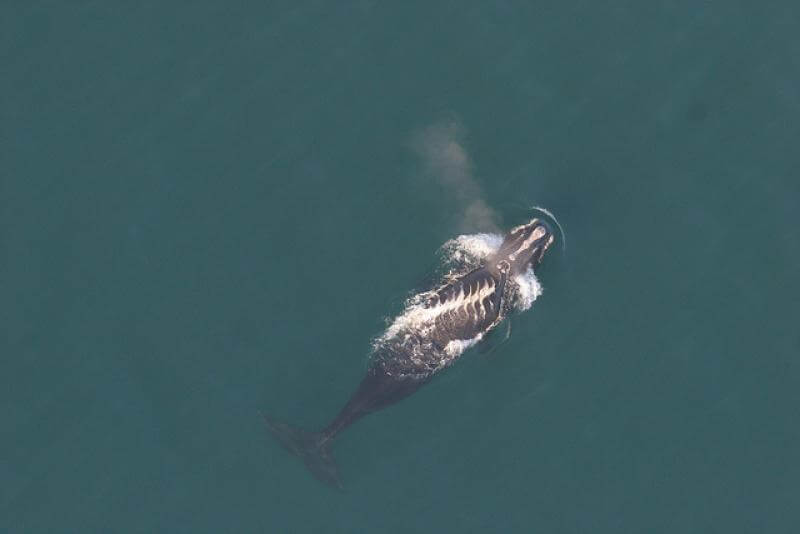
Right whale swimming offshore of South Carolina on Jan. 20, 2011 with propeller wounds across its back. The whale has not been re-sighted since. Credit: EcoHealth Alliance (NOAA permit #594-1759).
Because not all deaths are observed (for example, when a whale is struck offshore and the carcass sinks rather than washing up onshore), scientists use the term cryptic mortality to refer to whale deaths that go undetected. The percentage of undetected deaths due to vessel strike can vary between species depending on distribution and monitoring frequency. For example, North Atlantic right whales are found close to shore, are frequently monitored, and healthy right whales are fairly robust, making them more likely to float after death. Despite these factors increasing the likelihood of detection, approximately 64% of right whale deaths by whatever cause are never observed. Cryptic mortality of other large whale species is likely much higher.
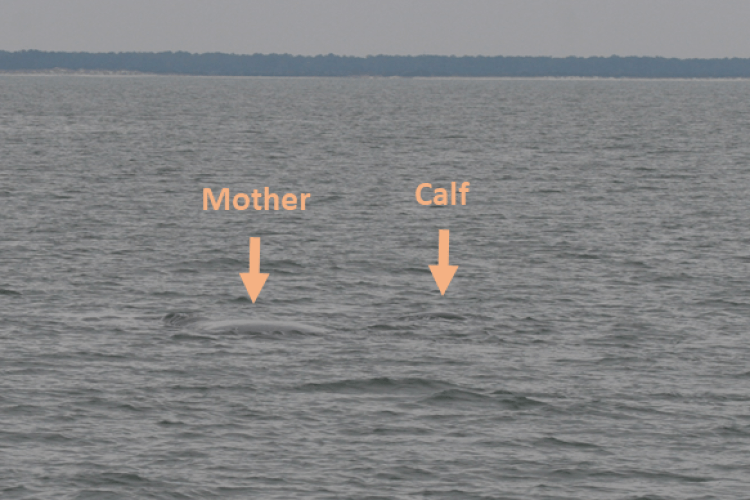
North Atlantic right whales can be difficult for mariners to see because they have no dorsal fin. Mother-calf pairs also spend a lot of time resting at the surface, increasing their risk of vessel strike. (NOAA Permit #594-1467-02)
Depending on the specific needs and behavior of the species at risk, the pattern of vessel traffic, and the areas of highest risk, several options can help reduce the risk of vessel strikes in U.S. waters: Traffic separation schemes and routing measures, Areas To Be Avoided, and Speed Limits.
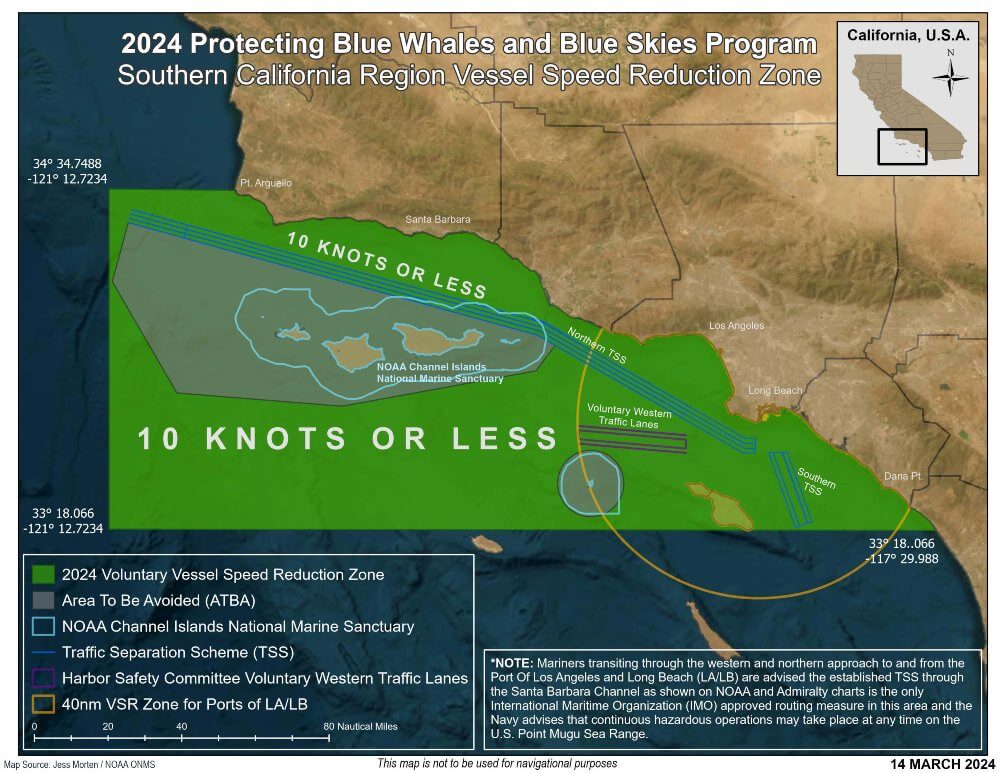
Examples of Vessel Speed Limits, Areas To Be Avoided, and traffic separation schemes are seen along the coast of Southern California (Jess Morten, NOAA Office of National Marine Sanctuaries).
Traffic separation schemes and routing measures are measures that require an analysis of whale distribution and movements, vessel traffic patterns, and navigational hazards. Once a route has been identified that reduces the potential for overlap between whales and vessels, the proposed new routing is considered through a public review and comment process that is initiated by the U.S. Coast Guard, in consultation with NOAA. Once the proposed measures have been adopted domestically, they are taken to the International Maritime Organization (IMO) for review and final approval. The new shipping lanes or routes are then incorporated into navigational charts and advisories for both foreign and domestic vessels traversing U.S. waters.
Areas To Be Avoided are areas that require special protections from vessel traffic due to frequent and persistent use by large whales. Once identified, they go through a similar public review and approval process, by the U.S. Coast Guard and then IMO, as routing measures. They can apply to all or certain classes of vessels, can be voluntary or mandatory, and can be implemented year-round or seasonally. Informal areas to be avoided can also be identified and implemented in U.S. waters outside of the formal U.S. Coast Guard and IMO process.
Vessel speed limits can be voluntary or mandatory and implemented in specific places of high vessel strike risk year-round, seasonally, at certain times of day, or as needed when whales are present. Studies have shown that 10-knot speed limits are the most effective in reducing risk of vessel strike mortality and serious injury of large whales. Exceptions to the speed limits are permitted as necessary to ensure human safety and safety of navigation.
Yes, small boats can also injure and kill whales, especially calves. In fact, five of the 12 North Atlantic right whale deaths in U.S. waters that were caused by vessel strike from 2008-2022 were caused by vessels smaller than 65 feet in length.
Human safety and safety of navigation are always a top priority. Vessel speed rules implemented on the U.S. East Coast to reduce strikes of North Atlantic right whales, for example, allow deviations from the 10-knot speed limit whenever situations or conditions threaten human or navigational safety. It should be noted, however, that speed limits, especially for smaller vessels, may actually increase human safety. For example, in cases when small boats have struck North Atlantic right whales, the vessel operators often did not see the whale prior to the strike, or if they did, it was too late to avoid a collision. Collisions at high speeds can damage vessels and cause serious or fatal injuries to the people onboard.
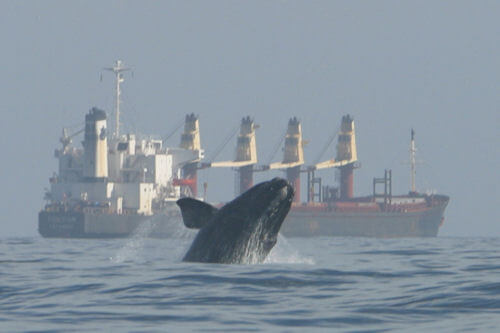
A North Atlantic right whale and cargo ship (Florida Fish and Wildlife Conservation Commission).
After Canada implemented routing measures in the Bay of Fundy in 2003, NOAA and the U.S. Coast Guard implemented recommended routing for vessels traveling through important right whale habitats in Cape Cod Bay and near ports in Georgia and Florida in 2006. In the following years, with approval from the IMO, the shipping lanes into and out of Boston were shifted further north to reduce overlap with whale foraging grounds. The IMO also designated the Great South Channel, off of Cape Cod, as a voluntary Area to be Avoided from April through July.
NOAA’s National Marine Fisheries Service (NMFS) adopted vessel speed measures in 2008 to reduce vessel strikes of North Atlantic right whales. The rule requires that vessels 65 feet and longer travel at speeds no greater than 10 knots when transiting designated seasonal management areas (SMAs). SMAs are only active in certain places and times of year when right whales are present. At the same time, NMFS implemented a separate dynamic management area program that would allow for voluntary speed restrictions to be established in areas and at times when right whales are detected outside of active SMAs. In 2022, after reviewing the data on right whale vessel strikes, NMFS proposed changes to the vessel speed rule to provide greater protections. Those changes included replacing the SMAs with five Seasonal Speed Zones, expanding the rule to include vessels between 35 and 65 feet in length, making speed limits in dynamic speed zones mandatory, and enhancing data collection in support of safety deviations.
Final action by NMFS on the proposed amendments is still pending.
In 2013, recommendations made by the U.S. Coast Guard and NOAA prompted the IMO to shift shipping lanes off San Francisco, Los Angeles, and Long Beach into areas with less overlap between vessels and large whales. In addition, the NOAA Office of National Marine Sanctuaries established voluntary speed reduction zones from May through December. During those times, vessels 300 gross tons and larger are requested to travel 10 knots or less. The vessel speed reduction zones now include the traffic separation schemes off San Francisco and southern California, the Greater Farallones, Cordell Bank, and Monterey Bay National Marine Sanctuaries, and an expanded Area to be Avoided that encompasses the Channel Islands National Marine Sanctuary and adjacent waters.
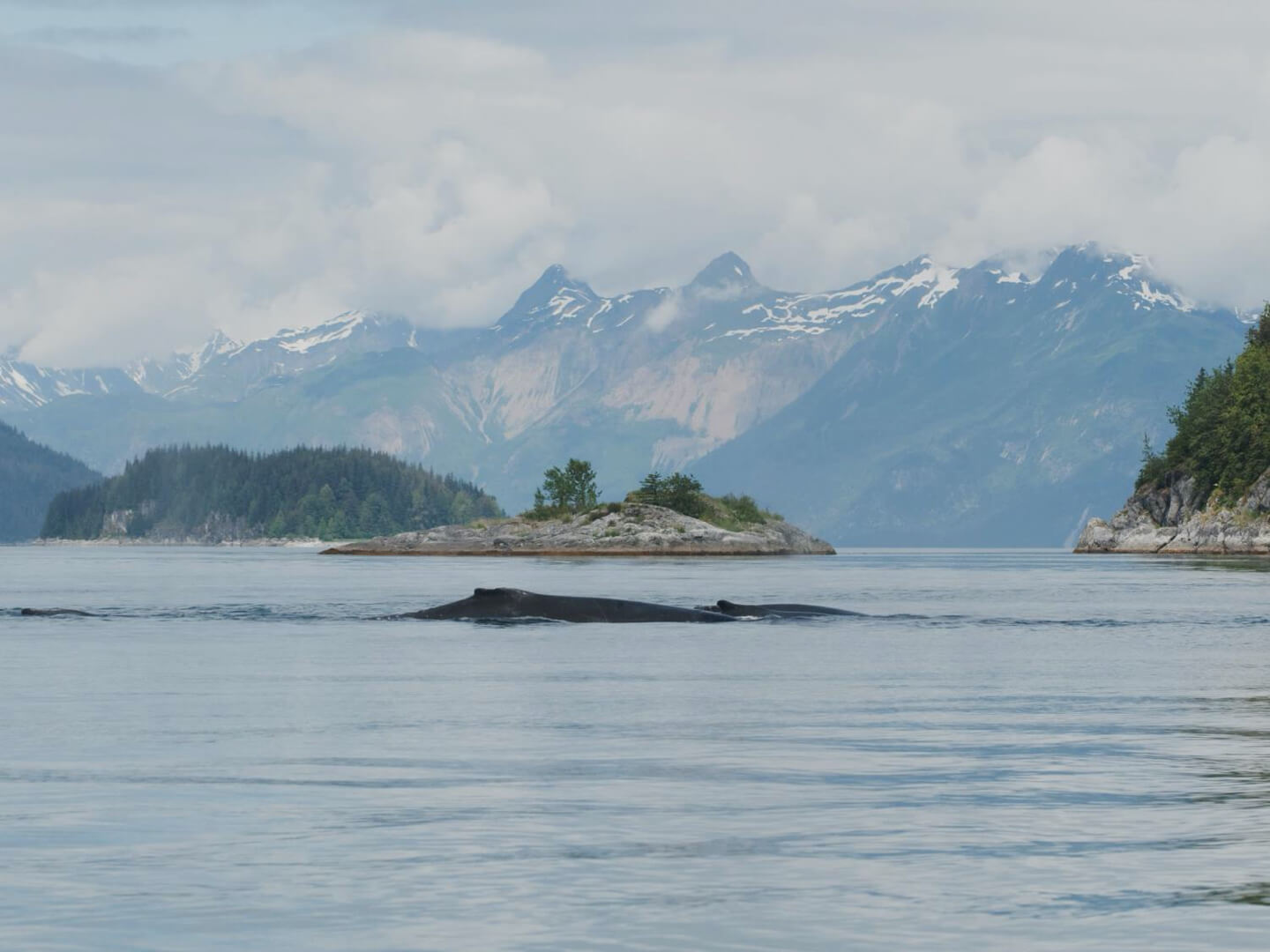
Humpback whale in Glacier Bay National Park, Alaska. (Christine Gabriele, Glacier Bay National Park).
Although not specifically developed to address vessel strikes of large whales, the U.S. Coast Guard and the IMO adopted voluntary routing measures, including recommended routes, precautionary areas, and Areas to be Avoided in the Bering Strait and Bering Sea in 2017. The U.S. Coast Guard is currently developing similar routing measures for the Arctic Ocean, north of the Bering Strait. In response to the U.S. Coast Guard’s 2018 request for information, the Commission recommended routing measures and vessel speed restrictions in the Chukchi and Beaufort Seas that would decrease the risk of vessel strikes of large whales that migrate through the Bering Strait, along the western Alaska coast, and Barrow Canyon. The Commission recommended also that vessels avoid the Hanna Shoal area in the Chukchi Sea, a summer foraging area for walruses. In Southeast Alaska, vessel speed measures are in place in Glacier Bay National Park to reduce the likelihood of vessels striking humpback whales.
Vessel strike reduction measures are not unique to the United States. Other countries, including Canada and Panama, have implemented similar measures to protect marine mammals. Vessels also have been requested to transit further offshore around the southern coast of Sri Lanka in order to reduce the risk of vessel strikes for blue whales. Voluntary mitigation measures also have been established in the northwestern Mediterranean Sea. In 2024, Greece committed to establishing a monitoring and early warning system that detects whales in real-time and urges ships to slow down or change course to avoid collisions.
Vessel strike reduction measures, including speed limits, have been successful in reducing the likelihood and lethality of vessel strikes of large whales. On the East Coast, the vessel strike mortality rate of right whales decreased from 10 deaths in the 10 years prior to implementation of the rule to four deaths in the 10 years after the rule was implemented. There was an apparent increase in the number of serious and non-serious injuries after the rule was implemented; however, this may have been influenced by increased reporting during that time. On the West Coast, vessel strike reduction efforts may have reduced vessel-strike mortalities by 9 to 13%.
The success of vessel strike reduction measures depends on operator compliance, which has been a challenge. Compliance with voluntary measures has been low, and in some areas on the West Coast, resulted in little to no reduction in the estimated vessel strike mortality. Mandatory measures have achieved up to 88% compliance on the East Coast, and incentive measures have achieved 78% compliance on the West Coast. Ensuring compliance with, and ultimately the effectiveness of, future measures is essential to reducing injury and mortality.
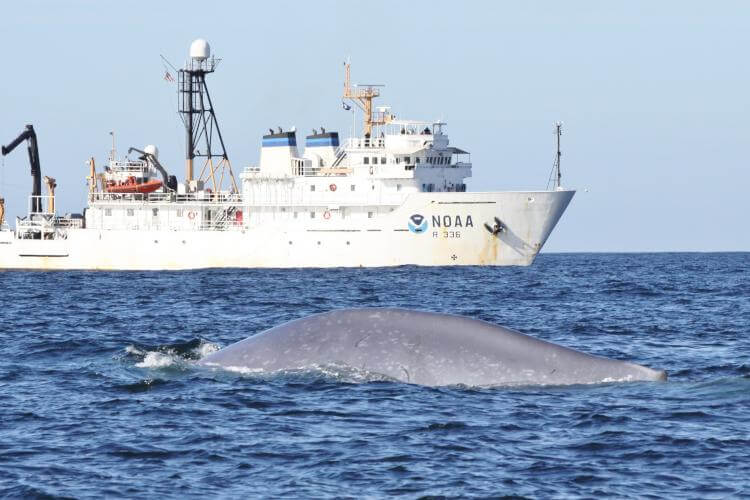
A blue whale surfacing in the North Atlantic ocean during a NOAA research cruise (NOAA Fisheries Permit No. 779-1633).
Aerial and vessel-based surveys and passive acoustic monitoring technology are used to identify and track the presence of large whales. In some cases, these technologies can detect whales in near real-time and it is possible to alert mariners to their presence. Additional technologies, including satellite detection and thermal imagery, are being developed to further enhance whale detection capabilities. NOAA’s ASTER^3 program was recently established to advance the conservation and recovery of protected species through innovative technology.
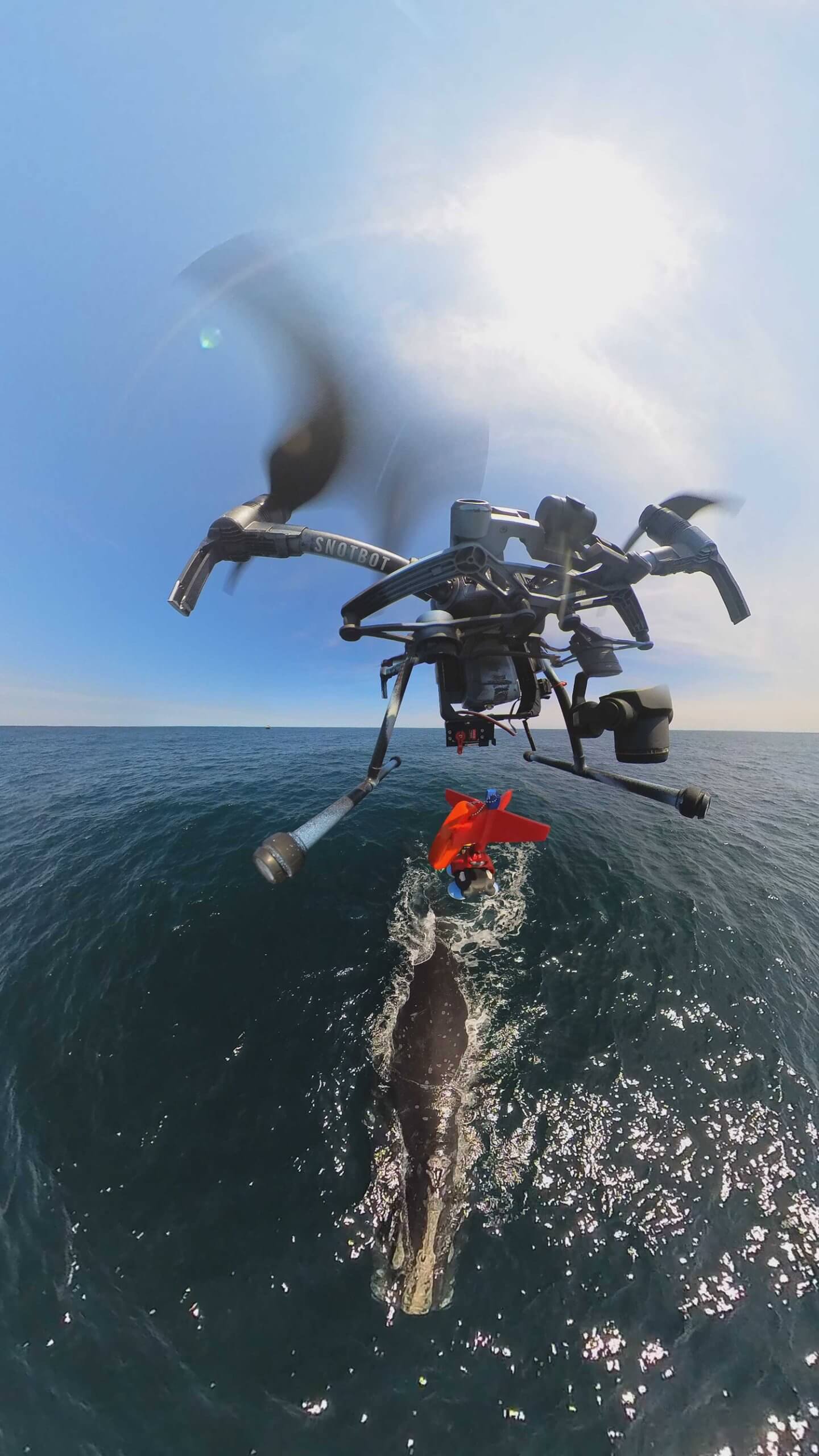
Scientists use drones to drop tags on North Atlantic Right Whales (Ocean Alliance/Chris Zadra, NOAA Fisheries Permit #24359).
Each tool has limitations, so managers will likely use a combination of tools to build whale detection capability as these new technologies advance. For example, visual surveys only detect animals near the surface and rely on observer presence and good weather conditions, while passive acoustic monitoring can detect whales subsurface when observers are not present, but requires whales to be vocalizing. Multiple technologies, used in combination with traditional vessel strike reduction measures, will likely be the most effective way to reduce the risk of vessel strike to large whales.
Climate change and warming ocean temperatures can cause shifts in the distribution of marine mammals and their prey. As marine mammals move into new areas without established protections, they may be at a higher risk from human activities. This phenomenon was observed as North Atlantic right whales moved into the Gulf of St. Lawrence in search of their copepod prey. Following that shift in whale distribution, increases in vessel strike mortalities were observed. Similar situations are likely to continue occurring in the future. We need to ensure that marine mammal monitoring programs and modelers have the capacity to detect or predict these changes in distribution as early as possible, and that managers are able to quickly and adaptively implement and amend protection measures as necessary.
IWC – Ship Strikes: collisions between whales and vessels
NOAA Fisheries – Reducing vessel strikes to North Atlantic right whales
NOAA Fisheries – Vessel strikes
MMC – Federal agency approaches to reducing vessel strike of cetaceans webinar
NOAA Fisheries – Vessel Information Fact Sheet
NOAA Fisheries Background Paper on North Atlantic Right Whale Vessel Strikes
In 1994, the Marine Mammal Protection Act (MMPA) was amended to establish a system for assessing the status of marine mammal stocks in U.S. waters and reducing their incidental take in commercial fisheries. Those amendments provide the current basis for managing interactions between fisheries and marine mammals. They require the National Marine Fisheries Service (NMFS) and the U.S. Fish and Wildlife Service (FWS) to:
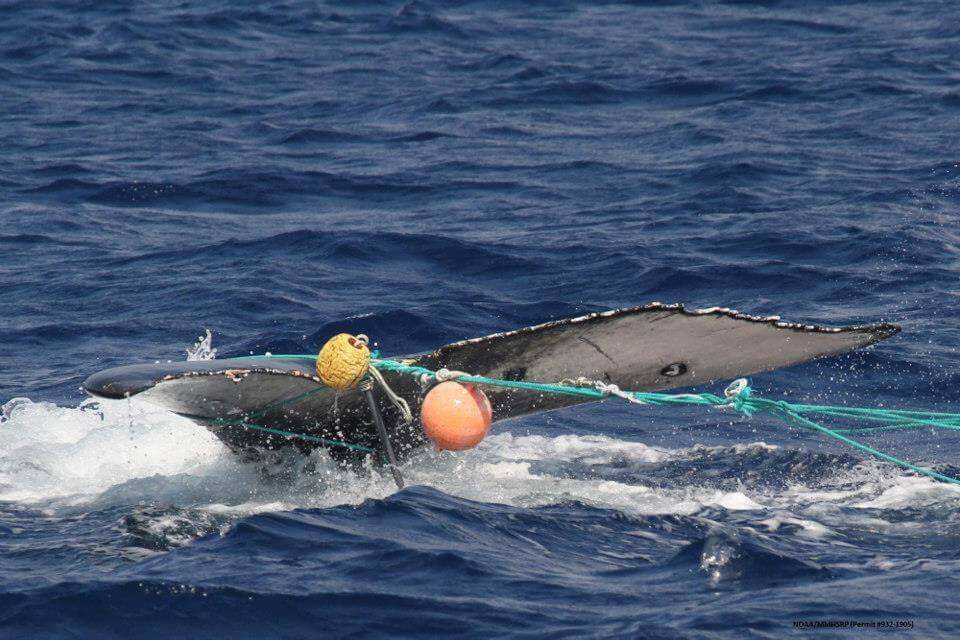
A humpback whale entangled in fishing gear. Photo taken under NOAA MMHSRP permit #932-1905. (NOAA)
NMFS is responsible for the protection and management of all whales, dolphins, and pinnipeds (except walruses) while the FWS is responsible for manatees, sea otters, walruses, and polar bears.
Section 117 of the MMPA requires NMFS and FWS to prepare and periodically update marine mammal stock assessment reports for each stock occurring in U.S. waters under their respective jurisdictions. Each stock assessment report is to describe the geographic range of the stock and estimates of its minimum population size, population trend, current and maximum net productivity rates, and potential biological removal level. The potential biological removal (PBR) level is an estimate of the number of individuals that could be taken as a result of human activities while still allowing the stock to recover to or remain within the envelope of its optimum sustainable population size. PBR is calculated from a stock’s minimum population estimate, maximum net productivity rate, and a recovery factor that is designed to provide additional protection based on the relative status of the stock under consideration and account for uncertainties other than those associated with the abundance estimate. Stock assessment reports also are required to describe for each stock the commercial fisheries it interacts with and the total number of mortalities and serious injuries to marine mammals caused by human activities. Finally, each report must categorize the stock as either ‘strategic’ or ‘not strategic.’ Stocks that are listed as ‘threatened’ or ‘endangered’ under the Endangered Species Act (ESA), or ‘depleted’ under the MMPA, are considered to be ‘strategic’ by default. Other stocks are categorized as ‘strategic’ if estimates of human-caused mortality and serious injury for the stock exceed its PBR level. Comments submitted by the Commission on NMFS Stock Assessment Reports are listed below (see “Learn More” section).
Section 118 of the MMPA requires NMFS to classify each U.S. fishery into one of three categories according to the frequency with which the fishery incidentally kills or seriously injures (referred to here as ‘takes’) marine mammals relative to the PBR level of each of the marine mammal stocks with which the fishery interacts:
The List of Fisheries is reviewed and updated annually. The Marine Mammal Commission provides formal comments and recommendations on the NMFS List of Fisheries (see letters section below).
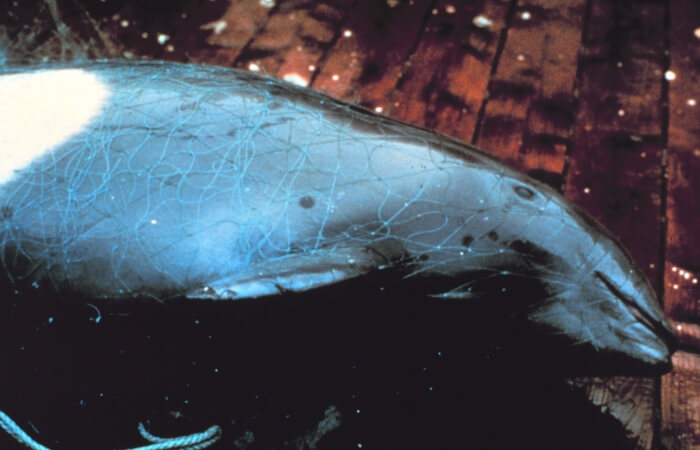
Entangled Dall’s Porpoise (Phocoenoides dalli). (NOAA)
Section 118 of the MMPA also directs NMFS to prepare a take reduction plan (TRP) for each ‘strategic’ marine mammal stock that interacts with a Category I or Category II fishery. Such plans also may be developed when a Category I fishery has a high level of mortality and serious injury involving one or more marine mammal stocks, even though it does not exceed PBR. Individual TRPs often address multiple marine mammal stocks and fisheries with similar or related incidental take problems. In accordance with the MMPA, the goals of a TRP are to (1) reduce mortality and serious injury to less than a marine mammal stock’s PBR with six months of the plan’s implementation date, and (2) reduce serious injury and mortality to insignificant levels approaching a zero rate within five years. That insignificance threshold is defined by NMFS as less than 10 percent of PBR, or what is known as the zero mortality rate goal (ZMRG).
NMFS uses Take Reduction Teams (TRTs) to develop recommendations for measures to be included in take reduction plans and to monitor the implementation of those plans until NMFS has determined that the goals have been met. Team members include representatives of relevant fisheries, conservation groups, the academic community, fishery management organizations, and involved federal and state agencies. A representative of the Marine Mammal Commission participates on all TRTs. To date, seven TRTs have been established (see table below). The Atlantic Trawl Gear TRT has not met in over a decade, but the rest of the TRTs are still active.
1996
Take of right, humpback, and fin whales in various Atlantic coast trap and gillnet fisheries for lobster, crabs, conchs/whelks, groundfish, monkfish, sharks, hagfish, and other finfish.
1996
Take of short-finned pilot, sperm, pygmy sperm, humpback, and beaked (Cuvier’s, Baird’s, and Mesoplodon spp.) whales in Pacific drift gillnet fisheries for sharks and swordfish.
1997
Take of harbor porpoises in various Atlantic coast set gillnet fisheries for groundfish (e.g., haddock, cod, and flounder), coastal finfish, spiny dogfish, and monkfish.
2001
Take of bottlenose dolphins in various mid-Atlantic set gillnet, trap, seine, and pound-net fisheries for coastal finfish, dogfish, and crabs.
2005
Take of long- and short-finned pilot whales and Risso’s dolphins in Atlantic coast pelagic longline fisheries for swordfish, sharks, and tuna.
2006
Take of long-finned and short-finned pilot whales, common dolphins, and Atlantic white-sided dolphins in Atlantic coast trawl net fisheries for various finfish, squid, and shellfish.
2010
Take of pelagic and insular stocks of false killer whales in Hawaii-based deep-set and shallow-set longline fisheries.
Marine mammal bycatch refers to any marine mammal adversely affected as a result of being unintentionally entangled, entrapped, or caught by nets, lines, traps, or hooks, or otherwise impacted by fishing gear. Bycatch is the greatest direct cause of marine mammal injury and death in the United States and around the world. Sections 118 and 101(a)(5)(E) of the Marine Mammal Protection Act (MMPA) requires the National Marine Fisheries Service (NMFS) and the U.S. Fish and Wildlife Service (FWS) to address marine mammal bycatch through science, gear research, and restrictions on fishing gear and practices.
National Bycatch Strategy
NMFS has developed priorities and strategies for reducing fisheries bycatch at the national level, as part of its 2016 National Bycatch Reduction Strategy, which exists to support sustainable fisheries and the recovery and conservation of protected species. Those priorities and strategies include the following:
Comments submitted by the Commission on NMFS’s National Bycatch Strategy are listed under “Learn More”.
The federal management framework for monitoring and mitigating bycatch is based on assessment of the ability of marine mammal populations to sustain human-caused impacts (the sustainable ‘potential biological removal’ level, or PBR, of each stock), estimation of the numbers of animals seriously injured or killed, and take-reduction efforts based on structured consultations among fishery managers, scientists, conservationists, and fishermen on NMFS’s take reduction teams (TRTs). The Commission is an active member of each of the five recently active TRTs. The Marine Mammal Commission’s 2014 Priorities Report underscored the need for regular stock assessments for marine mammal species that are affected by bycatch. Enabling such assessments requires increased observer coverage within and across fisheries to ensure estimates of bycatch are reliable and up to date. Observed bycatch is typically a fraction of the deaths and serious injuries that actually occur so it is extrapolated to estimate the total for the entire fishery. However, many deaths go undetected because fisheries are unobserved, or would be undetected even if observers were onboard the fishing vessels. These unobserved and undetected deaths are sometimes referred to as ‘cryptic mortality’. For example, roughly two-thirds of all North Atlantic right whales deaths go undetected. The Commission has provided presentations on marine mammal cryptic mortality at two NMFS workshops to address the problem of fully accounting for deaths that are not accounted for through observer data or strandings.
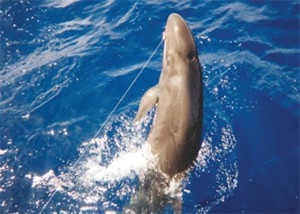
Hooked false killer whale from the Hawaii long-line fishery. (Eric Forney, NOAA PIRO)
One way the Commission works toward reducing bycatch globally is through its grants and research program. In recent years (2018–2023), the Commission funded ten research projects addressing marine mammal bycatch. The Commission also regularly engages with Congress on the science and policy decisions related to marine mammal bycatch. For example, in 2016, the Commission co-hosted with the World Wildlife Fund (WWF) a Congressional briefing to increase awareness of the impacts of marine mammal bycatch at national and international levels. The Commission is also looking for ways to create economic incentives for reducing marine mammal bycatch. In September 2015, the Commission co-hosted an international workshop on incentive-based fishery bycatch measures with the NMFS. This workshop focused on incentives such as individual transferable bycatch allocations to provide greater flexibility to fishing vessel operators to reduce their marine mammal bycatch in a more cost-effective manner. In 2019, the Commission helped plan a workshop that examined economic aspects of bycatch, including how economic mechanisms can incentivize bycatch mitigation, as part of NMFS’s National Bycatch Reduction Strategy.
At the 2017 Biennial meeting of the Society for Marine Mammalogy, the Commission co-organized and co-funded a one-day international workshop on marine mammal bycatch along with WWF and NMFS. In presentations and panel discussions, workshop participants highlighted creative tools to address the challenges of data-poor, open-access, small-scale fisheries. Incentivizing measures such as market access and economic alternatives were also raised as alternative solutions for a wide variety of fisheries. The workshop report, which covers this and two other workshops on marine mammal bycatch during the meeting, can be found here.
Multilateral and regional organizations such as the FAO Committee on Fisheries and Regional Fishery Management Organizations, respectively, are key institutions in addressing global fishery bycatch. At the Indian Ocean Tuna Commission Working Party on Ecosystems and Bycatch, Marine Mammal Commission-funded scientists were able to draft an Executive Summary for cetaceans that occur in the region, where limited data suggest that bycatch interactions in coastal gillnet fisheries may be more common than previously recognized.
At the Commission’s 2019 Annual Meeting one session explored the factors affecting bycatch of odontocetes (dolphins and toothed whales) in a variety of hook-and-line fisheries in and around the Hawaiian Archipelago. At the Commission’s 2023 Annual Meeting, the closing session title, “Whales on the Brink”, considered the substantial threats facing to North Pacific and North Atlantic right whales, including entanglement in fishing gear.
Take Reduction Teams (TRTs) around the United States review and recommend specific bycatch reduction measures for particular fisheries (e.g., Atlantic pot/trap, California drift gillnet, Hawaii shallow- and deep-set longline) through a negotiated, multi-stakeholder process. Those measures are reflected in Take Reduction Plans (TRPs) for each fishery or group of fisheries. The TRTs are mandated to work toward the goal of reducing marine mammal bycatch to levels below PBR within six months, and to levels approaching the zero mortality rate goal (defined as 10% of PBR or less) within five years. Not all TRTs have been successful, and the Commission continues to strive for effective measures and their full implementation and enforcement through active participation on all the TRTs. The Commission’s 2015 Annual Meeting included a session examining TRT performance, with a specific discussion of the factors determining successes and challenges in some of the East Coast TRTs.
Learn more about TRTs and the development of take reduction plans.
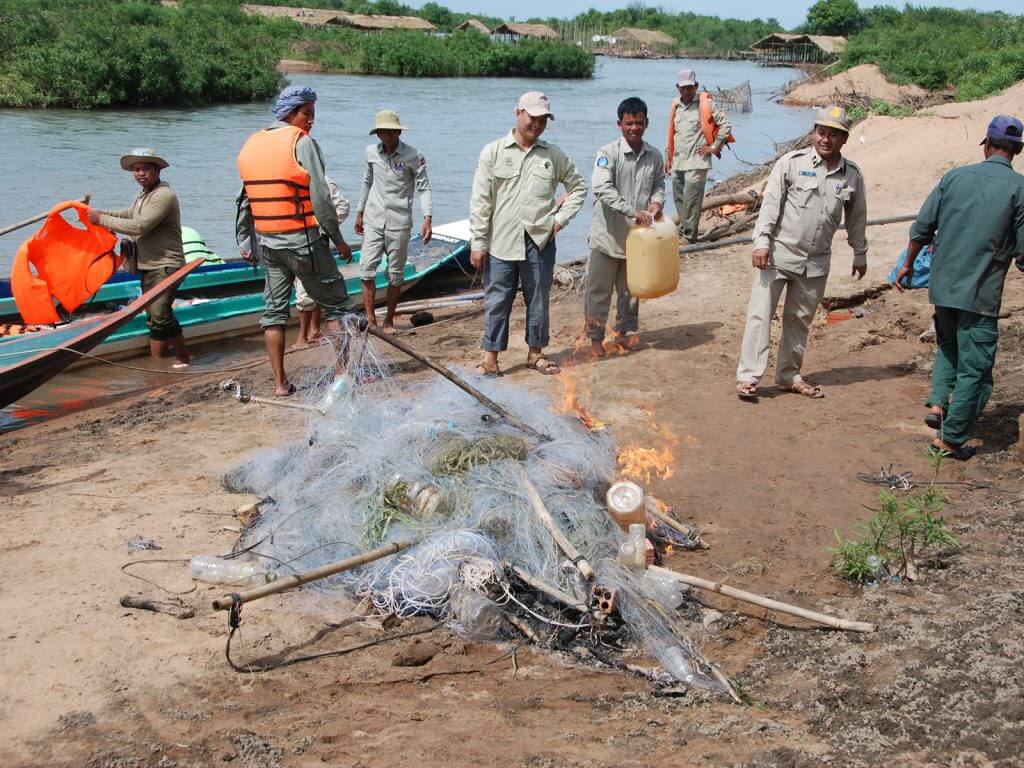
Mekong river guards of the Cambodian Fisheries Administration burn gillnets removed from within Core protected zones for the Mekong River population of Irrawaddy dolphins. (Peter Thomas, Marine Mammal Commission)
In 2016 the Commission spearheaded a global bycatch reduction initiative that was announced at the 2016 Our Ocean Conference. U.S. government agencies joined the Environmental Defense Fund, The Nature Conservancy, the Natural Resources Defense Council, and the International Seafood Sustainability Foundation to provide $1.7M to enable fishing nations to better monitor and prevent bycatch in global fisheries, supporting sustainable, ecosystem-based fisheries worldwide. The list of projects focuses on technological, policy and legal capacity building. This initiative dedicates $375K to address marine mammal bycatch on a global level. The Commission has the lead in tracking progress on this initiative and reported to the Department of State on ongoing progress on the ten elements of this initiative in preparation for the 2017 Our Oceans Conference.
The International Whaling Commission launched its Bycatch Mitigation Initiative in 2016, with the goal of developing, assessing and promoting effective bycatch prevention and mitigation measures worldwide. The Marine Mammal Commission nominated several independent scientists to the Initiative’s Expert Panel, all of whom were appointed. In 2023, one of the Commission’s staff members was appointed to the Expert Panel.
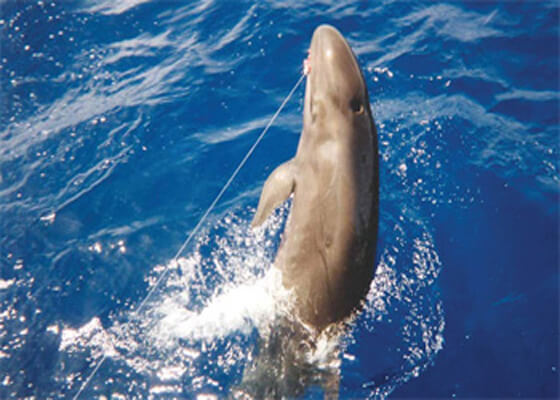
Hooked false killer whale from the Hawaii long-line fishery. (Eric Forney, NOAA)
Reliable bycatch data are critical to develop policy measures aimed at reducing the impacts of fisheries on marine mammals. Elements needed to accurately assess and mitigate the impacts of bycatch on marine mammals include:
In many cases, the insufficiency of resources for collecting accurate fisheries and marine mammal data has resulted in poor or out-of-date information, particularly those needed to calculate PBR. The uncertainty and inadequacy of data can create a need for measures that are more restrictive than necessary, leading to unwarranted economic losses in commercial fisheries. Studies have shown that a modest increase in resources to support marine mammal data collection can result in more targeted bycatch reduction measures and less impact on the “bottom line” of commercial fishermen. Additional research is needed to better understand the ecological effects of fishing on marine mammals and marine ecosystems, which are even more challenging to define, assess, and mitigate.
In 2014 and 2015 the Commission co-sponsored two workshops with NMFS to look at innovative and cost-effective ways of collecting marine mammal stock assessment data. One workshop, held in October 2014, examined the use of unmanned aerial systems (UASs or drones) to survey marine mammals, and to collect data on body condition and behavior. The second workshop, held in April 2015 focused on the use of passive acoustics deployed on fixed or towed arrays, or housed in floated buoys or autonomous underwater vehicles (gliders), to detect and estimate the density of marine mammals from their calls.
As part of the National Bycatch Reduction Strategy, the Commission assisted NMFS in the planning and execution of a workshop that in October 2019 examined the connections between the economy and bycatch, including that of protected species such as marine mammals. It was clear from the presentations and discussion that bycatch has a number of impacts on the profitability of fisheries, and that the economy has both positive and negative effects on bycatch. A workshop report will be published in 2020.
The Consortium for Wildlife Bycatch Reduction
Commercial fishing operations are the largest cause of human-related injury and death for many marine mammals. The Marine Mammal Commission supports and strives to advance sustainable fisheries practices that minimize the impact to marine mammals and their environment. The Marine Mammal Protection Act (MMPA) establishes an extensive research and management framework for assessing and mitigating marine mammal bycatch in commercial fisheries. A key feature of this framework has been the development of take reduction plans developed in consultation with take reduction teams to reduce high levels of marine mammal bycatch. While this process, in most but not all cases, has resulted in considerable progress in reducing marine mammal bycatch, additional scientific and management efforts are needed to address the indirect impacts of fishing on the complex predator-prey dynamics for marine mammals.
2019 Annual Meeting
In Hawaii, as in many places around the world, many odontocetes (dolphins and toothed whales) take bait or catch off fishermen’s hooks (depredation), and are occasionally, accidentally caught themselves. In part, the Commission’s 2019 Annual Meeting focused on this problem, considering the factors affecting this form of bycatch in Hawaii and methods for its mitigation.
Fisheries can have negative or positive impacts on marine mammals, and the reverse is also true. Direct negative impacts on marine mammals include unintentionally injuring or killing them, or intentionally harvesting them. Indirect negative impacts include reducing the availability of, or altering the size or diversity, of their prey. Habitat degradation caused by certain fishing activities (e.g., bottom trawling) can also have an indirect, negative impact on marine mammals that depend on those habitats for food. Conversely, fisheries can have a positive impact on marine mammals by increasing the availability of prey, which can happen directly when fishing gear flushes or concentrates fish, which then are consumed by marine mammals before they are caught by the gear, or indirectly by increasing the abundance of preferred prey, perhaps by reducing the abundance of the prey’s competitors or predators. Marine mammals can have a direct, negative impact on fisheries by removing bait or caught fish from hooks, nets, or traps or mariculture pens (a behavior called depredation), scaring fish away from fishing gear, or damaging or removing fishing or mariculture gear. In some cases, fishermen seeking to protect their gear or, catch or penned fish may harass marine mammals that are interacting with their gear, sometimes, perhaps inadvertently, causing injury or death.
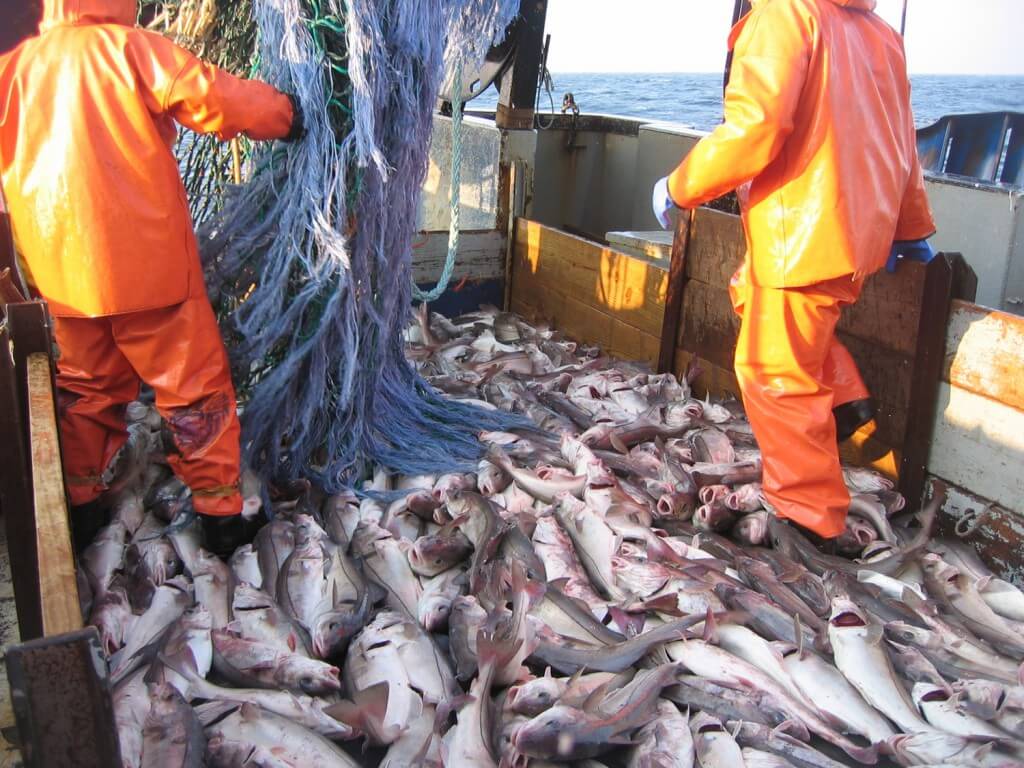
Fishermen sort their catch from an “eliminator trawl” (Rhode Island Sea Grant)
Bycatch is the number one source of direct human-caused death and serious injury to marine mammals worldwide, estimated at over 650,000 individuals each year. Two important publications (see the Learn More section of this page) have highlighted the significant threat that gillnets, in particular, pose to marine mammals around the world. While the United States has made significant progress in reducing the impact of fisheries operations on marine mammals, fishery bycatch remains a serious problem in other countries. In some cases, fishery bycatch threatens to drive species, such as the vaquita in the Gulf of California, to extinction. Although marine mammals can be bycaught in gear being actively fished, they can also be bycaught in lost, abandoned or discarded gear, a phenomenon called ‘ghost fishing.’ One review of 76 publications on this topic found reports of over 1800 cetaceans entangled in ‘ghost gear’. While the United States is a leader when it comes to sustainable fisheries management, over 90 percent of the seafood we consume is imported. For this reason, the Commission supports regulations by the National Marine Fisheries Service that fully implement Section 101(a)(2) of the MMPA requiring import bans on seafood caught in foreign fisheries whose bycatch injures or kills marine mammals in excess of U.S. standards.
In some fisheries, marine mammals are known to remove catch or bait (depredation) regularly from fishermen’s lines or nets, and some species (primarily pinnipeds) take fish from mariculture pens. Over thirty species of odontocetes are known to engage in depredation. For example, some individuals in populations of sperm, killer, false killer, and pilot whales around the world have become adept at removing a variety of fish species from longline hooks, a behavior also exhibited by other toothed whales and dolphins in a wide range of fisheries. Other species have learned to take catch from trawl or gill nets. Unfortunately, depredating marine mammals occasionally make a mistake and are hooked or trapped, which can result in serious injury or death.
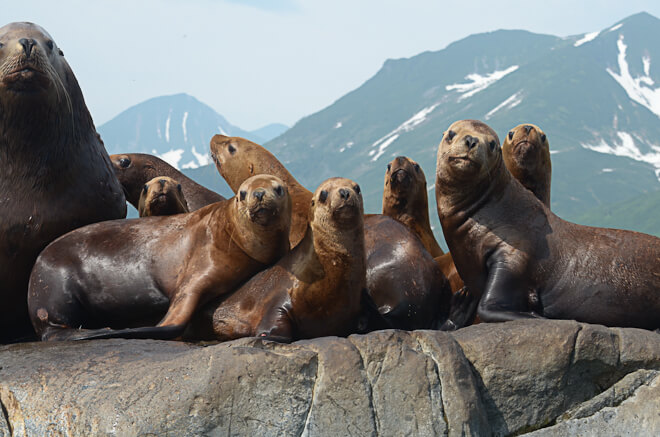
Steller sea lions range along the North Pacific Rim from northern Japan to California. (NOAA’s National Marine Mammal Laboratory)
Depredation can significantly affect the volume and quality of catches, and therefore profits, lead to fishermen taking potentially deadly retaliatory actions, and increase the likelihood of entanglement or hooking of marine mammals. The Commission is working with the National Marine Fisheries Service (NMFS) and other partner agencies to better understand impacts of depredation on marine mammals and find possible solutions, such as through the development of non-lethal deterrents aimed at minimizing interactions between marine mammals and fishing gear. In early 2018, NMFS increased the threat categorization of a sablefish longline fishery in the Gulf of Alaska because of the potential for depredating sperm whales to be caught and seriously injured or killed (see Commission letter commenting on this action).
In December 2014, NMFS sought comment on their intent to prepare national guidelines for the use of marine mammal deterrents (e.g., acoustic scaring devices, electrical wires, water jets, rubber bullets) that would not cause serious injuries or death. In response, in its recommendations the Commission emphasized the importance of clearly distinguishing between serious and non-serious injuries, using deterrents only when warranted, and preventing unrestricted use of noisemakers. To assist NMFS in its efforts, a Commissioner and Commission staff member attended a NMFS-hosted workshop in 2015 addressing non-lethal marine mammal deterrents for fishery operators as well as others impacted by recovering species. NMFS published a proposed deterrents guidelines in August 2020, but as of April 2021, the agency has yet to issue the final deterrent guidelines, nearly over six years after seeking public comment. In 2017, the Commission provided funding via its grant program to the Woods Hole Oceanographic Institution to characterize depredation in Northeast U.S. sink gillnet fisheries.
Several reviews of depredation occurring in a wide variety fisheries around the world have found that deterrents such as explosives and acoustic deterrent devices (ADDs) are largely ineffective. Changes in fishing gear (e.g., hook protectors or stronger traps) and practices (e.g., avoiding some areas or moving when depredation occurs) have proven to be much more effective.
The Commission works with the False Killer Whale Take Reduction Team and NMFS to amend the regulations of the Hawaii deep-set longline fishery to further reduce the likelihood that false killer whales are killed or seriously injured while depredating catch and bait in that fishery. Similarly, the Commission is working with the Pelagic Longline Take Reduction Team to reduce the bycatch of depredating pilot whales and Risso’s dolphins in by the Atlantic pelagic longline fishery to insignificant levels.
Indirect impacts of fisheries operations on marine mammals include competition for prey and damage or destruction of sensitive marine mammal habitat. While these and other indirect effects could be significant, they have received less attention by scientists and fishery managers, in part because of the difficulties in understanding complex marine ecosystems and food webs. Globally, fisheries have significantly reduced the size of many fish stocks and continue to unsustainably exploit them year after year. Removing a large portion of the biomass of a target fish stock may have severe effects on marine mammals and other predators that prey on the stock. In addition, some types of trawl and dredge fishing have been shown repeatedly to significantly alter the physical and biological structure of sensitive marine habitats, potentially affecting marine mammals that depend on those habitats.
Competition between fisheries and marine mammals is an issue in many fisheries. For example, in southeast Alaska, fishermen catching urchins, clams, and crabs have voiced concerns that sea otters are reducing their catches by consuming these species as part of their diet. Also, the impact of fisheries taking the prey of endangered Steller sea lions in Alaska or Southern Resident Killer whales in Washington has long been a concern and controversy. Reduction in key prey species by fishing could compromise the sea lions’ foraging efficiency and, consequently, their ability to survive, grow to maturity, and reproduce at rates sufficient for the population to recover. In part to mitigate this risk, fisheries management in the Aleutian Islands includes measures designed to reduce the fisheries depletion of certain fish stocks in areas of particular importance to Steller sea lions.
The Commission believes that indirect effects of fishing on marine mammal prey resources should be considered when establishing catch limits for fish stocks developed under fishery management plans required by the Magnuson-Stevens Fishery Conservation and Management Act. We have provided recommendations on proposed revisions to NMFS’s Magnuson-Stevens National Standard 1 Guidelines, highlighting some of our concerns regarding the impact of fisheries harvest on marine mammals. In particular, we recommend that the guidelines for determination of “Optimal Yield” adequately incorporate ecological factors, such as the role of the target fish species in the ecosystem, such as forage fish.
Marine mammals can consume substantial amounts of fish, in some cases comparable amounts to that taken by fisheries. It can be tempting to infer that marine mammals must be reducing the availability of fish to fishermen, but demonstrating such a link has proven to be very difficult because of the complexity of marine ecosystems, and because marine mammals are often only taking related species or size classes that are not targeted by fishermen. Similarly, clear demonstrations are lacking that fisheries have reduced marine mammal prey availability to limiting levels. A recent ecosystem simulation study of fisheries and three cetacean species in the Rías Baixas shelf ecosystem (North-West Spain) concluded that intense fishing would reduce the variety of available prey and lead to competition among the cetaceans.
The Atlantic States Marine Fisheries Commission’s (ASMFC) Menhaden Management Board has developed ecological reference points that take into account the requirements of menhaden predators, such as marine mammals, and that will be used to set ecosystem-based catch targets and limits. In a 24 October 2017 letter, the Commission encouraged the ASMFC to implement the use of ‘rule-of-thumb’ ecological reference points (ERPs) to manage the menhaden fishery until ERPs specific to this fishery can be developed. Stock assessment scientists with the ASFMC and NMFS completed development of the ERPs, and in January 2020 published a stock assessment of Atlantic menhaden using ecological reference points. In August 2020, the ASFMC approved ERPs that take into account the impact of menhaden fishing on striped bass. Although, the impact on marine mammals was found to be minimal, the development of ERPs that account for the needs of predators is an important step forward in fisheries management.
Marine Mammal Bycatch (Marine Mammal Commission)
Fisheries Interaction (NOAA Fisheries)
The Arctic has been an area of great global interest for oil and gas development. However, offshore oil and gas activities in the Arctic present risks to marine mammals and to the Alaska Native communities that depend on them for subsistence and cultural purposes. Those risks come from, among other things, sound generated by seismic surveys, drilling operations, and vessel and aircraft support activities; contamination from drilling and oil spills; and disruption of bottom habitats from temporary or permanent mooring or pipe-laying activities. The greatest risk to marine mammals and the marine environment is from oil spills, whether from drilling or ship-related accidents. Difficulties of responding to and cleaning up a major spill are heightened by the Arctic’s remoteness, harsh conditions, and relative lack of infrastructure, trained personnel, and response equipment.
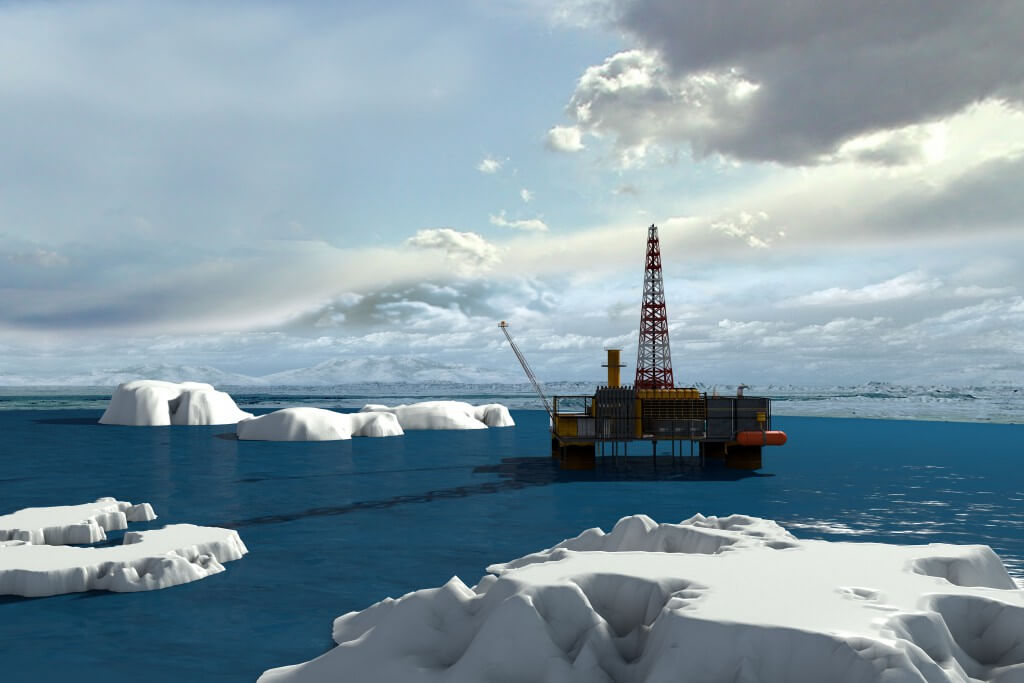
Hypothetical oil platform in the Arctic Ocean. (Shutterstock)
The Commission regularly reviews and comments on the Bureau of Ocean Energy Management’s (BOEM) proposed oil and gas leasing and development activities in the Arctic and on proposed Marine Mammal Protection Act (MMPA) incidental take authorizations issued by the National Marine Fisheries Service (NMFS) and the U.S. Fish and Wildlife Service (FWS) for oil and gas exploration, construction, and operations. We also comment on and promote environmental studies to better understand the potential effects of oil and gas activities on Arctic marine mammals, and facilitate efforts to identify and address priority information needs through convening of workshops and meetings.
The Commission has commented specifically on the need for better information on the long-term and cumulative effects of oil and gas exploration, particularly exposure to sound from seismic surveys, drilling, and other activities; whether bowhead whales and other marine mammals are showing signs of habituation to sound; and whether animals are altering migration routes and foraging patterns to avoid exposure to sound-related disturbance or in response to changing climate conditions. Also needed is the continued incorporation of Indigenous Knowledge in assessments of distribution, seasonal movements, behavior, and health of marine mammals as well as subsistence use patterns. Such information is critical for federal and state agency decision-making processes.
BOEM’s 2012-2017 five-year leasing program had two lease sales scheduled in the U.S. Arctic—one in the Chukchi Sea in 2016 and one in the Beaufort Sea in 2017. The Commission submitted comments to BOEM on each of the two proposed lease sales (see letters section below). In October 2015, the Department of the Interior cancelled both lease sales citing market conditions and low industry interest.
In January 2015, President Barack Obama withdrew large portions of the Chukchi and Beaufort Seas from new offshore oil and gas drilling, under authority of Section 12(a) of the Outer Continental Shelf Lands Act. In December 2016, the President signed Executive Order 13754 on Northern Bering Sea Climate Resilience, which excluded from oil and gas leasing portions of the Bering Sea planning areas (the Norton Basin Planning Area and lease blocks within the St. Matthew-Hall Planning Area lying with 25 nautical miles of St. Lawrence Island). That same month, the President expanded the 2015 withdrawal to include nearly all of the Chukchi and Beaufort Sea planning areas. The 2017-2022 leasing program was approved in January 2017 and did not include any lease sales in the Arctic, consistent with President Obama’s directive.
In April 2017, President Donald Trump issued an Executive Order directing the Secretary of the Interior to consider revising the schedule of oil and gas lease sales for 2017-2022 to include those areas within the Beaufort and Chukchi Sea that had been previously withdrawn from leasing, among other directives. BOEM subsequently initiated the development of a new five-year National OCS oil and gas leasing program for 2019-2024 that considered leasing in all but one of the Alaska planning areas. That program was never implemented due to litigation.
On 20 January 2021, President Joseph Biden signed Executive Order 13990 reinstating Executive Order 13754 on Northern Bering Sea Climate Resilience and the 20 December 2016 Presidential Memorandum, which restored the withdrawal of the Chukchi Sea, portions of the Beaufort Sea, and portions of the Bering Sea from oil and gas leasing. In the Executive Order, the President also called for a temporary moratorium on all Federal activities related to the implementation of the Arctic National Wildlife Refuge Coastal Plain Oil and Gas Leasing Program in order to conduct a review, and as appropriate, a new comprehensive analysis of the potential environmental impacts of the oil and gas program. That review was initiated in June 2021 by DOI Secretarial Order 3401. In November 2024, BOEM released a Supplemental Environmental Impact Statement (EIS) to the 2019 Coastal Plain Oil and Gas Leasing Program EIS to provide a comprehensive analysis of the potential environmental impacts of the program, including addressing the deficiencies identified in Secretary’s Order 3401.
More information regarding oil and gas leasing on the U.S. Outer Continental Shelf, as well as links to relevant Commission comment letters, can be found on the Commission’s Oil and Gas Development and Marine Mammals webpage.
Oil and gas exploration activities in the Arctic substantially increased in the early 2000’s. Interest was spurred in part by estimates of significant reserves in offshore waters of the U.S. Arctic Outer Continental Shelf (OCS). BOEM estimates of undiscovered technically recoverable resources of oil and gas in the Arctic in 2021 underscore the significance of the U.S. Arctic for potential oil and gas development, with 35 percent of the total U.S. potential offshore oil and gas resources contained in Arctic planning areas (27 percent in the Chukchi Sea and 8 percent in the Beaufort Sea).
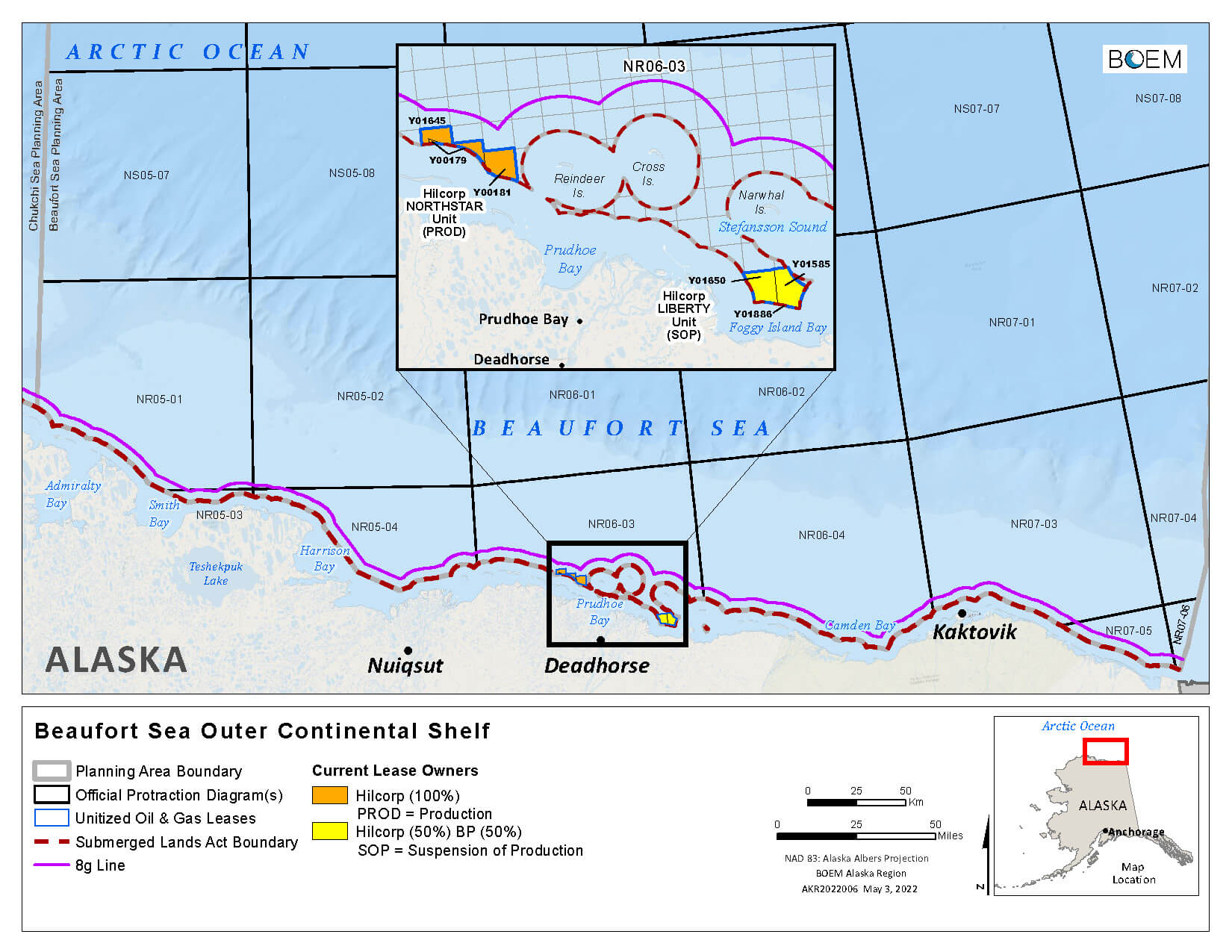
Map of active leases in the Beaufort Sea, Alaska, as of May 2022. (BOEM)
Exploration activities in the Chukchi and Beaufort Seas since the most recent Arctic lease sale in 2008 have included seismic surveys, shallow hazards site surveys, and limited exploratory drilling. In 2012, Shell attempted to drill exploratory wells in both the Chukchi and Beaufort Seas, but was unsuccessful. In 2015, Shell drilled an exploratory well in the Chukchi Sea but failed to find any meaningful quantities of oil or natural gas. Shell subsequently announced that it would halt exploration efforts in the Arctic. All remaining leases in the Chukchi Sea have since been relinquished by Shell and others.
In July 2017, BOEM approved plans for Eni US Operating Co. Inc. to conduct exploratory drilling in federal waters from its Spy Island drill site, an existing man-made island in Alaska state waters. The drill site is north of the Nikaitchuq oil field, about three miles off Oliktok Point, in the Beaufort Sea. In April 2018, BOEM approved a revision to Eni’s exploration plan that allowed for drilling in Summer 2018. Eni initiated drilling a well at Nikaitchuq North in 2018 but suspended drilling operations in April 2019. BOEM has since notified Eni that its leases in Harrison Bay have expired.
Production drilling in U.S. Arctic federal waters is currently limited to the Northstar facility in the Beaufort Sea, which began producing in 2001. Northstar is a joint federal/state of Alaska project originally operated by BP Exploration Alaska Inc., but now operated by Hilcorp Alaska LLC. It is located about 12 miles northwest of Prudhoe Bay.
A new offshore production facility was approved for construction in 2018 at Hilcorp Alaska LLC’s Liberty oil field, also in the Beaufort Sea. BOEM finalized its Environmental Impact Statement (EIS) analyzing the potential impacts of Liberty’s Development and Production Plan in August 2018. However, a legal challenge to stop the project was approved by the Ninth Circuit in December 2020, citing BOEM’s failure to quantify emissions resulting from foreign oil consumption in its EIS and the Fish and Wildlife Service’s failure to account for non-lethal takes of polar bears in its ESA biological opinion. Hilcorp is currently updating its Oil Spill Response Plan for Liberty, which, once approved, would likely result in Liberty amending its Development and Production Plan. BOEM would then be obligated to prepare a new or supplemental EIS to reflect Liberty’s changes to the plan and to address shortcomings in the original EIS.
In July 2016, the Bureau of Safety and Environmental Enforcement (BSEE) and BOEM issued a final rule governing exploratory drilling activities on the U.S. Arctic Outer Continental Shelf. The regulations were intended to ensure that exploratory drilling activities in the Arctic Ocean are conducted in a safe and responsible manner, while protecting marine, coastal, and human environments, and Alaska Natives’ cultural traditions and access to subsistence resources. In December 2020, BSEE proposed revisions to weaken the 2016 Arctic drilling rule, but the proposed revisions were withdrawn in June 2021.
Seismic surveys and drilling activities have the potential to harm marine mammals. Learn more about stages of oil and gas development and potential impacts to marine mammals.
Oil and gas exploration in the Arctic (i.e., seismic surveys and drilling) has the potential to affect the availability of marine mammals to Alaska Natives for subsistence. Section 101(b) of the MMPA provides for the taking (harvest) of marine mammals “by any Indian, Aleut, or Eskimo who resides in Alaska and who dwells on the coast of the North Pacific Ocean or the Arctic Ocean if such taking is for subsistence purposes or for the purpose of creating and selling authentic native articles of handicrafts and clothing”, and “is not accomplished in a wasteful manner.”
Oil and gas exploration in the Arctic has the potential to significantly disrupt Alaska Native subsistence practices. Unless effectively managed, exploration activities, including drilling and seismic surveys, can directly interfere with hunting activities or disturb marine mammals through increased human presence and noise. The increased vessel traffic associated with these operations raises the risk of ship strikes, oil spills, and other forms of pollution, all of which pose threats to the health of marine mammals hunted for subsistence.
The Alaska Eskimo Whaling Commission have jointly entered into annual Conflict Avoidance Agreements (CAAs) with oil and gas companies and seismic operators to minimize disturbance of the spring and fall bowhead whale subsistence hunts. The agreements specify areas and times that industry must not operate so as to avoid disturbing marine mammals before a hunt. The agreements also require the use of village-based communication centers to relay information between hunters and industry regarding planned operations and marine mammal presence and movements. The CAAs have generally been considered successful in minimizing impacts on subsistence activities, and hunters have recommended that future agreements be expanded to include other species besides bowhead whales and also to address other potentially harmful activities, such as shipping and fishing. They noted the agreements must also be enforceable by the federal government.
NMFS regulations require that applicants for incidental harassment authorizations prepare a Plan of Cooperation (POC) that identifies measures that have or will be taken to minimize adverse effects on the availability of marine mammals for subsistence purposes. Although POCs are not structured as “consensus” agreements (as are CAAs), they are enforceable.
In 2014, the National Research Council’s report, Responding to Oil Spills in the U.S. Arctic Marine Environment, highlighted the lack of adequate oil spill response tools, capabilities, and infrastructure for any large spill that might occur in the U.S. Arctic. The report, sponsored in part by the Commission, called for testing of current and emerging technologies in realistic conditions, using carefully controlled field experiments. The report recommended the use of a rigorous decision process, such as the Net Environmental Benefits Analysis, to evaluate different response options and associated environmental impacts that may result. Response options identified for the Arctic include biodegradation, chemical dispersants, oil herding agents, in situ burning, and mechanical containment and recovery (learn more about potential impacts of response activities on marine mammals); however, additional research is needed to inform decision-making regarding response options under various scenarios. The severe shortage of housing, fresh water, food, sewage handling and garbage removal facilities, communications infrastructure, supplies, and hospitals and medical support were cited as a major limitation in launching an effective response effort in the Arctic. The report noted that better communication and planning is needed among the various federal and state agencies that would be involved in oil spill response and with international partners, such as Canada and Russia. Also needed is oil spill training for local communities and integration of local traditional knowledge of ice and ocean conditions and marine life to enhance the effectiveness of oil spill response.
BSEE has increased efforts to conduct oil spill response research after the Deepwater Horizon oil spill, and has funded efforts to expand research on response equipment and methods in icy conditions, such as the effectiveness of dispersants in ice, in situ burning in ice conditions, and remote sensing of oil in and under ice. BSEE has also finalized drilling regulations for the Arctic to prevent an oil spill, and is developing stronger analytical capabilities to model spill trajectories and worst case discharge scenarios and to conduct training and drills in the event of a spill.
The oil and gas industry also has significant responsibilities to enhance oil spill response capabilities in Arctic conditions. Currently, the majority of resources and trained personnel for oil spill response in the Arctic are located in the Beaufort Sea, near Prudhoe Bay. However, additional capabilities are under development on the Northwest Coast of Alaska, along the Chukchi Sea coast. A number of international oil and gas companies have launched a collaborative effort to enhance Arctic oil and gas capabilities globally as part of the Arctic Oil Spill Response Technology Joint Industry Programme.
In 2013 the Arctic Council’s Working Group on Emergency Prevention Preparedness and Response (EPPR) developed an Agreement on Cooperation on Marine Oil Pollution, Preparedness and Response in the Arctic. The voluntary agreement, signed by the United States and several other Arctic nations, is intended to strengthen cooperation, coordination, and mutual assistance among the signatories on oil pollution preparedness and response in the Arctic. In 2017, EPPR and BSEE convened a workshop to share information and discuss the latest advances in oil spill response technology and best practices relevant to the Arctic region. A follow-up workshop to discuss next steps specific to international collaboration on oil spill response research was held in 2019 in Norway; a link to the report of that workshop is available here.
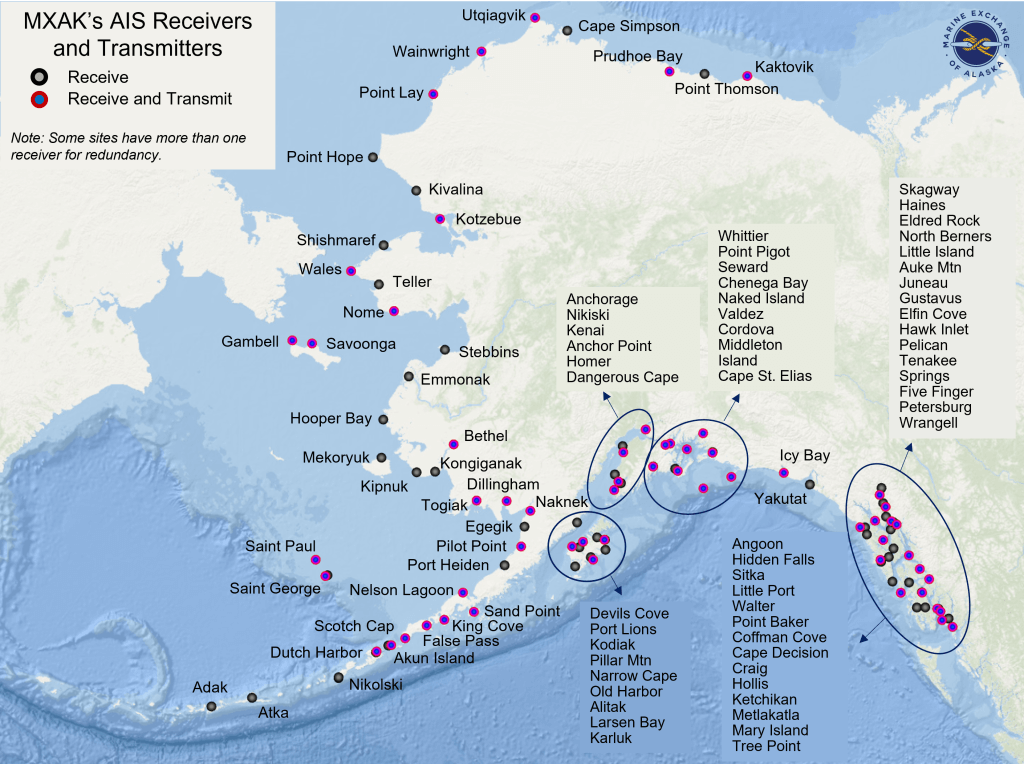
Marine Exchange Alaska’s AIS Receiver and Transmitter Stations
Recognizing that oil spill prevention and avoidance of maritime accidents are much more cost-effective than oil spill response and clean-up, the non-profit Marine Exchange of Alaska (MXAK) has developed an expansive vessel tracking system in Alaska with over 125 Automatic Identification System (AIS) receiving stations to aid safe, secure, efficient and environmentally sound maritime operations. Vessel owners, operators, ports, the Coast Guard, the State of Alaska and other authorized users may view vessels’ locations via MXAK’s secure system. MXAK staff track vessel movements to provide valuable safety, navigational and logistics information to the maritime community and to provide a virtual “Safety Net” that also contributes to the efficiency of maritime operations.
Responsibility for responding to Arctic marine mammals in the event of a spill requires a coordinated effort among federal, state, and local agencies, Tribes, industry partners, and contracted Oil Spill Removal Organizations. These entities follow response protocols as prescribed in the Wildlife Protection Guidelines for Oil Spill Response in Alaska.
Partly in response to the 1989 Exxon Valdez oil spill both FWS and NMFS have developed marine mammal-specific oil spill response guidelines, and have conducted training, workshops, and drills for their designated marine mammal stranding response organizations and veterinarians. For example, NMFS’s Pinniped and Cetacean Oil Spill Response Guidelines and Arctic Marine Mammal Disaster Response Guidelines provides information and guidance on communications with other responders and the public, documentation of injuries (including sample data collection forms), care and rehabilitation of oiled animals, and making informed decisions for appropriate response during an oil spill event to supplement existing guidance in the Alaska Area Contingency Plans and the NMFS Pinniped and Cetacean Oil Spill Response Guidelines.
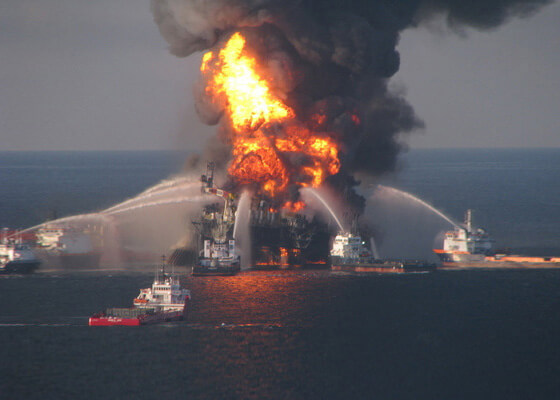
Fire boat response crews battle the blazing remnants of the offshore oil rig Deepwater Horizon April 21, 2010. Multiple Coast Guard helicopters, planes and cutters responded to rescue the Deepwater Horizon’s 126 person crew (U.S. Coast Guard)
On April 20, 2010, BP’s mobile offshore drilling unit Deepwater Horizon exploded, burned, and subsequently sank in the Gulf 52 miles southeast of Venice, Louisiana. Eleven of the 126 workers on the rig were killed and, over the following 87 days, an estimated 3.19 million barrels (~134 million gallons) of oil spilled into the Gulf (4.0 million barrels minus 810,000 barrels of collected oil). This was the largest oil spill ever reported in U.S. history. In comparison, the Exxon Valdez tanker spilled approximately 257,000 barrels (11 million gallons) of crude oil into Prince William Sound, Alaska, in 1989.
The Commission works with scientists and managers across the Gulf to refine and promote recovery and restoration strategies for marine mammals injured by the oil spill. We have outlined priorities for restoration and long-term monitoring, as well as concerns regarding potential impacts of some large-scale restoration projects on marine mammals, in letters (see letters section below) to the Deepwater Horizon Natural Resource Damage Assessment (NRDA) Trustees and the Gulf Coast Ecosystem Restoration Council. We have also submitted restoration project ideas to the various Trustee Implementation Groups through federal and state portals, and commented on draft restoration plans. The development and refinement of scientifically robust mitigation and monitoring measures to minimize impacts of offshore oil and gas and renewable energy activities on marine mammals, including impacts from oil spills, is one of the Commission’s six priority topics.
In January 2021, Commission staff facilitated a virtual workshop focused on enhancing conservation of bottlenose dolphins in Mississippi state waters. Bottlenose dolphins in Mississippi and throughout the Northern Gulf were significantly impacted by the Deepwater Horizon oil spill, and tracking recovery will require long-term monitoring and an ability to identify and minimize ongoing threats. Workshop participants from the National Marine Fisheries Service (NMFS), Mississippi-based marine mammal research and stranding network facilities, and Mississippi state agencies discussed current capabilities and research activities within the state and current knowledge regarding the status, stock structure, and major threats to bottlenose dolphins in Mississippi state waters. Discussions focused on critical uncertainties and opportunities for enhancing collaborations and expanding partnerships within the state and beyond to advance conservation efforts.
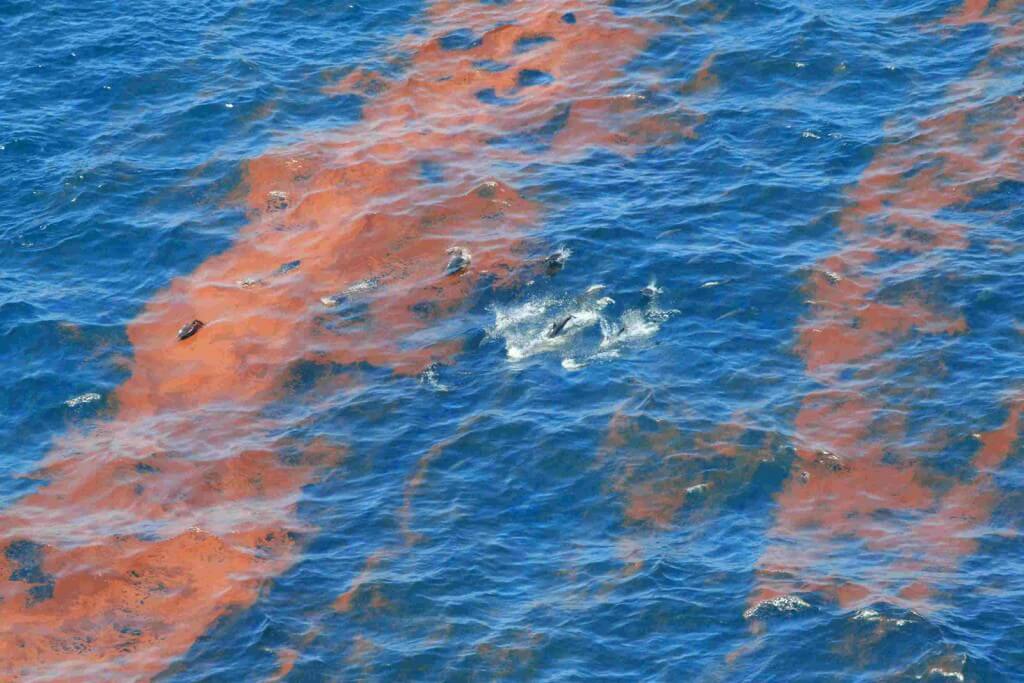
Dolphins swimming in oiled waters in the Gulf (Source: NOAA)
In April 2015, the Commission and several federal agency, academic, and non-governmental organization partners convened the Gulf of Mexico Marine Mammal Research and Monitoring meeting in New Orleans. The objectives of the meeting were to:
View the meeting summary and copies of presentations.
In August 2011, the Commission released the report, Assessing the Long-term Effects of the BP Deepwater Horizon Oil Spill on Marine Mammals in the Gulf of Mexico: A Statement of Research Needs. The report outlined the legal mandates for assessing the spill’s overall effects and reviewed the likely impact of the spill on Gulf marine mammals. It characterized research efforts, highlighted the overall need to improve assessment and monitoring of marine mammals in the Gulf, and outlined priorities for future research and restoration efforts, stressing the importance of long-term monitoring studies of both individual marine mammals and marine mammal populations.
The Commission’s 2010–2011 annual report (Chapter 3) provides more detailed information on the oil spill and wildlife response efforts immediately following the Deepwater Horizon explosion.
Responding to stranded or debilitated marine wildlife, especially to those that may have been exposed to oil, was a high priority during the days and months immediately following the Deepwater Horizon oil spill. In parallel with response efforts, the National Oceanic and Atmospheric Administration (NOAA) and the other Deepwater Horizon Trustees initiated the Natural Resource Damage Assessment (NRDA) process, as directed by the Oil Pollution Act of 1990. NOAA regulations implementing the Oil Pollution Act specify three phases for conducting damage assessments: (1) pre-assessment, (2) injury assessment and restoration planning, and (3) restoration implementation (for more information, see the diagram of phases involved in a Natural Resource Damage Assessment under the Oil Pollution Act of 1990). The Trustees’ pre-assessment confirmed in 2010 that Gulf natural resources in state and federal waters had been damaged as a result of the spill. That determination initiated the next phase of the process: injury assessment and restoration planning.
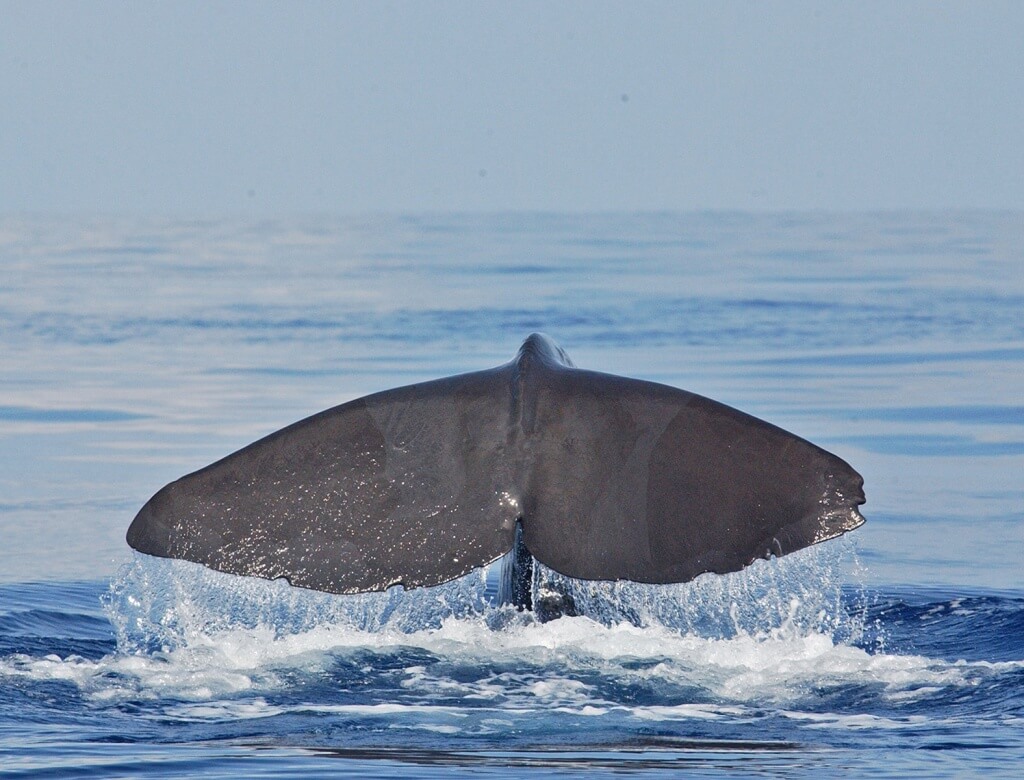
Movements and numbers of sperm whales were tracked after the spill using satellite tags and passive acoustic monitoring. Photo taken under NOAA permit # 779-1633. (NOAA Southeast Fisheries Science Center)
Injury assessments conducted under NRDA involved quantifying the impact on either a specific type of resource (e.g., marine mammals) or habitat (e.g., deepwater). Marine mammal injury assessment studies were conducted from 2010 to 2015 and included:
Assessing oil spill-related impacts to marine mammals was complicated by the occurrence of a cetacean unusual mortality event in the northern Gulf that began before the spill occurred, in March 2010. An analysis of bottlenose dolphin stranding patterns before and after the spill indicated that strandings from March to May 2010 were likely associated with exposure to cold and freshwater in and around Lake Pontchartrain, Louisiana. However, the majority of increased marine mammal strandings in the northern Gulf from 2010 to 2015 overlapped in space and time with the oil spill footprint. In addition, NRDA-related studies documented a myriad of adverse health issues in stranded and live-captured dolphins found within the affected area, such as persistent reproductive failure, adrenal disease, lung disease, and poor body condition.
Oil spill-related injuries, and guidance for restoring bottlenose dolphins and other injured marine mammals, are summarized in the Trustee’s Final Programmatic Damage Assessment and Restoration Plan (PDARP) and Final Programmatic Environmental Impact Statement, issued in February 2016. Many of those studies were compiled and published in a Special Issue of Endangered Species Research: Effects of the Deepwater Horizon oil spill on protected marine species (Volume 33, 2017).
A comprehensive bibliography of both NRDA and independent Deepwater Horizon oil spill-related marine mammal research and monitoring can be found here (updated April 2022).
Separate from the NRDA process, BP committed $500 million in May 2010 to be allocated over a 10-year period to investigate the impacts of the spill on the Gulf ecosystem and affected states. The funds were used to create the Gulf of Mexico Research Initiative (GOMRI) —a broadly focused, independent research program to be conducted primarily by Gulf research institutions. GOMRI operated from 2010 to 2020 and was overseen by a board of scientists selected by BP and the governors of the five Gulf states. Funding was awarded on a competitive basis and all data collected by grant recipients are being made publicly available on the Gulf of Mexico Research Initiative Information and Data Cooperative (GRIIDC) website. GOMRI-funded projects that focused on investigating the impacts of the oil spill on marine mammals included the following:
In April 2016, the U.S. District Court in New Orleans approved a settlement agreement with BP on all natural resource damage assessment claims under the Oil Pollution Act. That settlement agreement made available $8.8 billion (which included $1 billion already allocated for early restoration) to fund restoration and improvement projects, as designated by the Trustees in its programmatic restoration plan.
The Trustee’s 2016 restoration plan allocated funding to thirteen restoration types, including marine mammals, and across seven restoration areas: Alabama, Florida, Louisiana, Mississippi, Texas, regionwide, and open ocean. Additional funds were reserved for natural resource conditions and adaptive management needs that may be identified in the future.
The Trustees allocated $144 million in total funding for marine mammal restoration. Funds were allocated by area as follows: Alabama ($5M), Florida ($5M), Louisiana ($50M), Mississippi ($10M), Regionwide ($19M), and Open Ocean ($55M); Texas did not receive funding for marine mammal restoration.
The Trustees’ proposed approaches to achieve marine mammal restoration goals include:
The proposed restoration approaches are focused on restoration of marine mammal stocks determined to have been directly or indirectly impacted by the spill, particularly bottlenose dolphins, with some activities (e.g., gaining a better understanding of the causes of illness and mortality) expected to also benefit other marine mammal stocks outside the oil spill direct-impact area.
Trustee Implementation Groups (TIGs) have been established for each of the seven restoration areas and are charged with developing restoration plans that identify specific projects for each of the 13 restoration types. Plans for marine mammals are being developed in accordance with the Trustees’ Strategic Framework for Marine Mammal Restoration Activities.
To date, funding has been approved by the TIGs for the following marine mammal projects:
In September 2022 the Louisiana TIG announced the availability of its Final Phase II Restoration Plan #3.2: Mid-Barataria Sediment Diversion, in conjunction with the U.S. Army Corps of Engineers’ Final Environmental Impact Statement for the project. The project would involve the controlled release of freshwater and sediment from the Mississippi River into Barataria Bay, Louisiana, to rebuild lost wetlands. The Commission is concerned that the influx of freshwater into Barataria Bay would significantly impact the resident stock of bottlenose dolphins — dolphins that were also significantly impacted by the Deepwater Horizon oil spill. To better understand the effects of low salinity exposure on bottlenose dolphins, the Commission convened a meeting/webinar on March 23, 2021 with presentations from several experts on this topic. The agenda and background materials, as well as a recording of the webinar, is available here. Subsequent to the webinar, the Commission requested additional analyses on the potential effects of the proposed diversion project on Barataria Bay bottlenose dolphins, and how the project might delay the stock’s recovery from the effects of the 2010 Deepwater Horizon oil spill. A copy of that request and the results of that analysis are available here. Informed by these and other sources of information, the Commission recommended that the EIS be expanded to include a much more thorough vetting of possible alternatives that could reduce impacts on dolphin stocks, along with a discussion of whether each such alternative is practicable and would be consistent with the purposes of the project. The Commission has reviewed the Final EIS and continues to remain concerned that the proposed project is expected to result in the mortality of approximately 97 percent of the Barataria Bay stock of bottlenose dophins. The Commission’s comments to the U.S. Army Corps of Engineers and the Louisiana TIG on the Final EIS are here and also below.
More information on the development of restoration plans, including opportunities to provide public input and ideas for future projects, can be found on the Trustee’s website.
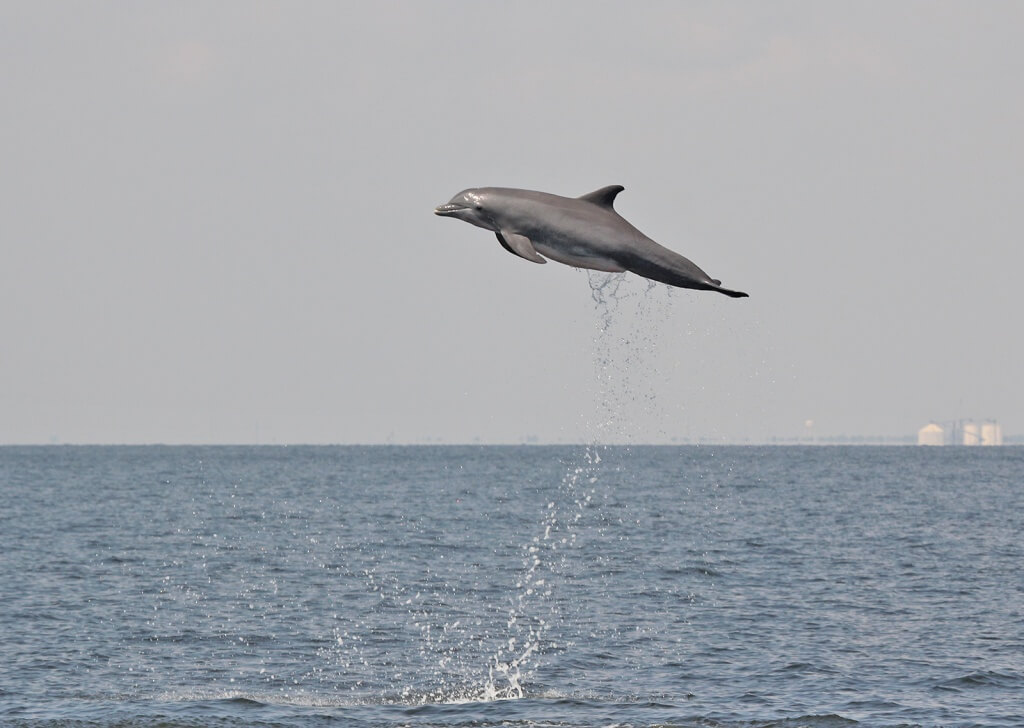
Health assessments of bottlenose dolphins from oil spill-affected areas revealed lung and adrenal gland injuries consistent with oil exposure. Photo taken under NOAA permit # 779-1633. (NOAA Southeast Fisheries Science Center)
Under the Oil Pollution Act, BP and the other parties responsible for the Deepwater Horizon oil spill are liable for costs associated with the removal of oil (i.e., clean-up costs) and for damages to natural resources and services caused by the spill, including the costs of assessing those damages. The responsible parties are also subject to civil and criminal monetary penalties under the Clean Water Act, which must be deposited in the Oil Spill Liability Trust Fund to be used for future oil spill clean-up activities. Those funds are not available for addressing damages caused by the Deepwater Horizon spill or for restoration activities.
In June 2012, Congress passed the Resources and Ecosystems Sustainability, Tourist Opportunities, and Revived Economies of the Gulf Coast States (RESTORE) Act of 2012. The RESTORE Act directed the Secretary of the Treasury to deposit 80 percent of Clean Water Act administrative and civil penalties paid by the parties responsible for the Deepwater Horizon oil spill into the Gulf Coast Ecosystem Restoration Trust Fund. The Trust Fund is being used to fund restoration of natural resources and economic recovery in the Gulf Coast region. The total available for RESTORE Act projects in the Trust Fund is approximately $5.328 billion.
The allocation of the Trust Fund has five components. Two of the five components are being allocated directly to the Gulf states through equal-share (35%) and impact-based (30%) allocations. The other three components are being allocated to the Gulf Coast Ecosystem Restoration Council (30%), the NOAA-led Restoration, Science, Observation, Monitoring, and Technology Program (also known as the NOAA RESTORE Act Science Program) (2.5%), and the State Centers of Excellence Research Grant Program (2.5%).
Additionally, $2.544 billion in Clean Water Act criminal penalties was provided to the National Fish and Wildlife Foundation (NFWF), establishing its Gulf Environmental Benefit Fund, and $350 million was provided to the National Academies of Sciences, Engineering, and Medicine (NASEM), establishing its Gulf Research Program. These funds are to be dispersed in grants to complement and expand Gulf restoration efforts. To date, the NFWF Gulf Environmental Benefit Fund has awarded grants to Alabama, Florida, and Mississippi to increase research, data collection, and stranding response capacity for Gulf marine mammals and sea turtles. The NASEM Gulf Research Program asked the Academies’ Ocean Studies Board to convene a committee to advise restoration funding programs regarding monitoring and evaluation of Gulf restoration activities and identify best practices. The committee provided its guidance for restoration, assessment, and synthesis in its report on Effective Monitoring to Evaluate Ecological Restoration in the Gulf of Mexico.
Environmental characterization and project planning data for the Gulf and other regions are now available through NOAA’s Data Integration Visualization Exploration and Reporting (DIVER) Explorer. In addition, NOAA’s Environmental Response Management Application (ERMA) is an online geographic information system (GIS) and visualization tool that allows users to view response, assessment, and restoration mapping layers in context with other environmental information.
The Gulf of Mexico Alliance (GOMA) is a partnership of the five Gulf states and other organizations whose goal is to increase regional collaboration to enhance the environmental and economic health of the Gulf. GOMA has developed the Deepwater Horizon Project Tracker as a tool to track restoration, research, and recovery projects resulting from the Deepwater Horizon oil spill.
The Environmental Law Institute’s Gulf Restoration and Recovery website provides a summary of ongoing oil spill-related research and restoration efforts.
BP’s Gulf Science Data website is a collection of publicly available datasets on Gulf-related scientific research.
The Gulf of Mexico Coastal Ocean Observing System (GCOOS) provides observational data, models, and products for a wide variety of users in the Gulf region, and is integrated with other regional coastal ocean observing systems to create an integrated and sustained U.S. component of the global ocean observing system.
Sea Grant in the Gulf of Mexico provides information to help increase knowledge and awareness of oil spill science topics, including the impacts of the oil spill on bottlenose dolphins and other wildlife.
The global development of renewable energy sources—wind, wave, solar, geothermal, biofuel, waste-to-energy, and tidal energy—represents an environmentally positive move away from more traditional, non-renewable sources, including fossil fuels. Fossil fuel resources are in finite supply, and developing and producing those resources can result in considerable impacts on the environment and human health. Burning fossil fuels produces carbon dioxide and other greenhouse gases that contribute to climate change. Increased domestic production of renewable energy is intended to address the nation’s longstanding goal of reduced dependence on foreign oil and gas energy sources while also helping to reduce greenhouse gas emissions.
The Marine Mammal Commission supports efforts to develop offshore renewable energy. Nevertheless, as with any new industrial activity proposed in U.S. coastal and offshore waters, the Commission believes that the development of renewable energy sources should proceed in a thoughtful and deliberate manner. Concerns have been raised regarding the potential impacts offshore of renewable energy development on marine mammals from the siting, construction, operation, and decommissioning of renewable energy facilities in coastal and offshore waters. It is important that we understand and prevent, to the extent possible, harmful impacts to marine mammals and other marine resources from renewable energy development.
The MMPA established a moratorium on the taking of marine mammals in U.S. waters. It defines “take” to mean “to hunt harass, capture, or kill” any marine mammal or attempt to do so.
The Commission regularly reviews and comments on the Bureau of Ocean Energy Management (BOEM) and the Federal Energy Regulatory Commission (FERC) proposed renewable energy activities and on the National Marine Fisheries Service’s proposed Marine Mammal Protection Act (MMPA) incidental take authorizations in all Outer Continental Shelf (OCS) planning areas. We also comment on and promote environmental studies to better understand the potential effects of renewable energy development on marine mammals.
Informational Factsheet: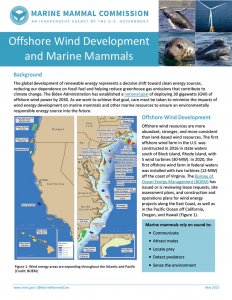
Check out the Commission’s factsheet on offshore wind and marine mammals.
Commission staff are actively involved in efforts of the Regional Wildlife Science Collaborative for Offshore Wind (RWSC) and other working groups to identify and fund short- and long-term priority research to evaluate impacts of offshore wind energy development on marine mammals and marine ecosystems. The RWSC has prepared a draft Science Plan to inform future data collection and research on issues related to offshore wind development, including information needs to better understand and mitigate impacts on marine mammals.
In October 2019, we participated on an expert panel convened by the Consortium on Ocean Leadership on Navigating the Development of Offshore Wind. The panel focused its discussion on reducing impacts of wind energy development on protected species, and future needs with respect to science, policy, regulation, and regional planning.
In March 2017, we participated on an expert panel convened by the BOEM to develop best management practices to guide the construction and operations of critical offshore infrastructure. The panel discussed the potential impacts of wind turbine construction, such as noise from pile driving and increased vessel traffic, on North Atlantic right whales and other marine mammal species. Mitigation and monitoring strategies were identified that could reduce impacts and fill key data gaps. Find out more about the workshop and view presentations here.
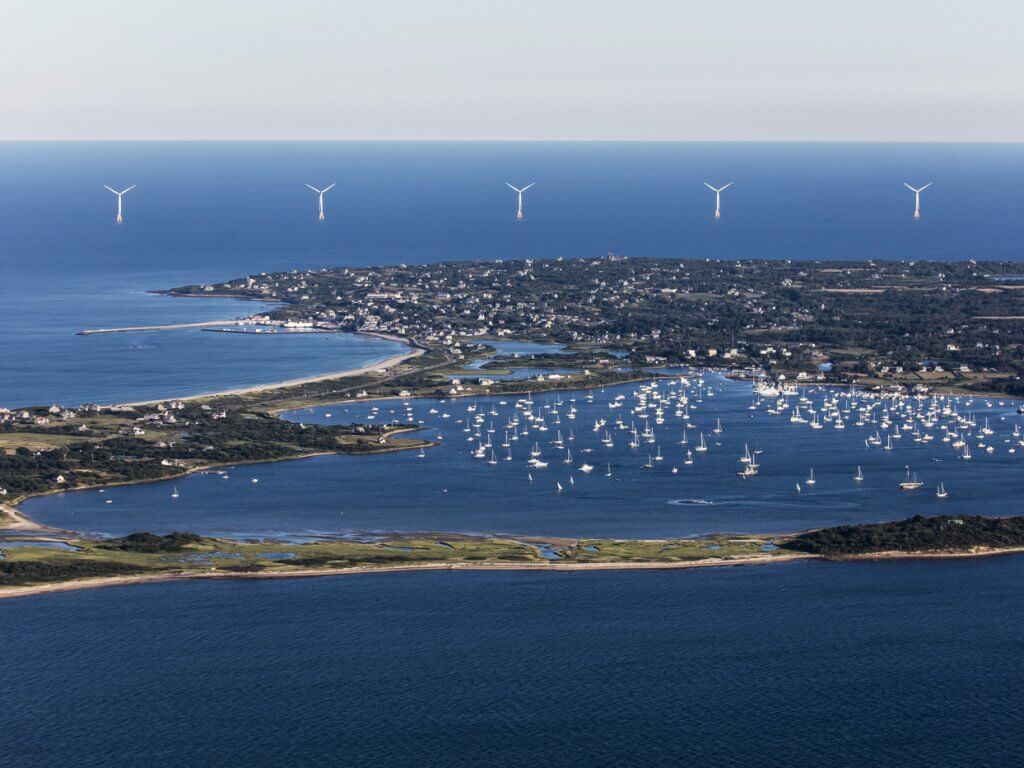
Block Island Wind Farm, off Rhode Island, was the first offshore wind farm to be installed in U.S. waters. (University of Rhode Island/Rhode Island Sea Grant)
Wind is a potentially large source of renewable energy from offshore waters. Offshore wind resources are more abundant, stronger, and more consistent than land-based wind resources. To meet growing interest in offshore wind development, BOEM has issued or is evaluating lease sales for wind energy development in the Atlantic Ocean from Maine to South Carolina, in the Gulf off Louisiana and Texas, and in the Pacific Ocean off California, Oregon, and Hawaii. [The Inflation Reduction Act of 2022 included a provision that would restrict BOEM from issuing new offshore wind energy leases unless an offshore oil and gas lease sale had been conducted within the previous year.]
The first offshore wind farm in the United States began operations in December 2016, in state waters near Block Island off Rhode Island. It has five turbines installed that can generate 30 megawatts of energy. Construction of a second wind farm, the first in federal waters, was completed off Virginia in June 2020. It has two turbines and can generate 12 megawatts of energy. BOEM has approved construction and operations plans for two other wind farms – Vineyard Wind 1 and South Fork (both in southern New England) – and several others are currently under review. See BOEM’s renewable energy website for state-by-state information on the status of wind energy development in U.S. offshore waters.
The development of offshore wind energy involves technology that is just beginning to be installed in U.S. OCS waters. Monitoring of wind farm construction and operation activities at various wind energy facilities outside the U.S. (primarily in the European Union) can provide some useful information regarding potential impacts of wind farms on marine mammals and seabirds. However, because of the different species involved and the potentially different wind turbine designs that may be installed in the U.S., considerable uncertainty exists regarding the potential short- and long-term impacts of offshore wind development on marine mammals that occur in U.S. waters (such as North Atlantic right whales). In general, more information is needed regarding impacts over the full life-cycle of wind energy activities on marine mammals as well as the cumulative effects of those activities in the context of natural and anthropogenic stressors.
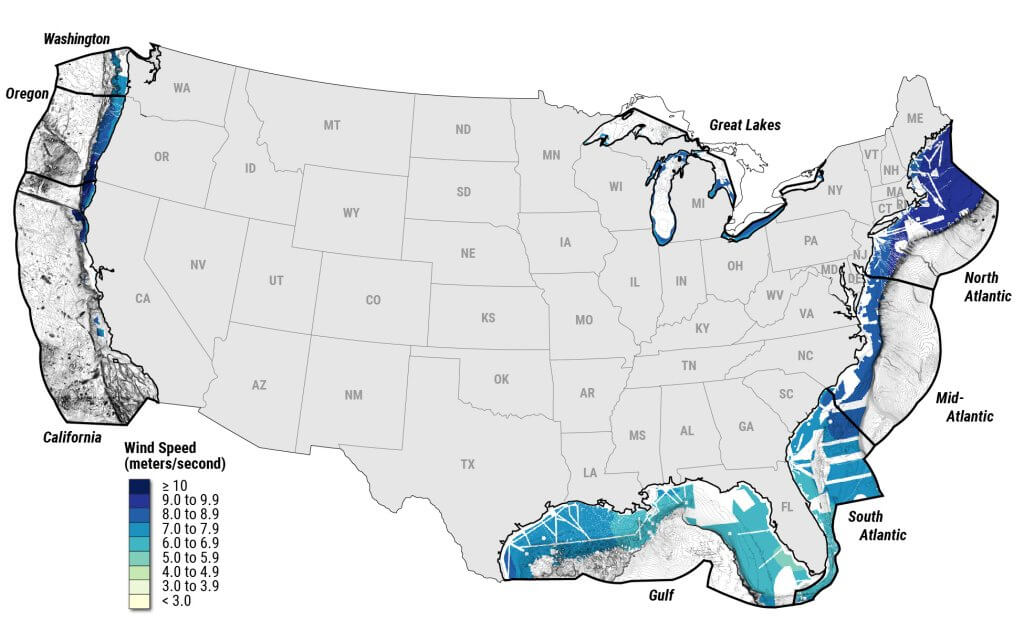
Offshore wind speeds for areas identified as developable for wind siting after all constraints applied. (Source: National Renewable Energy Laboratory 2022).
Of primary concern is sound generated by impact pile driving during construction of wind turbines. Depending on the size of pile driven and the type of pile driving hammer used, pile driving could impair hearing in marine mammals at close range and lead to changes in behavior at greater distances, including temporary or long-term displacement. For example, studies during construction of wind farms in Germany have indicated avoidance of pile driving activities by harbor porpoise as evidenced by a decrease in vocalizations in the study area. In other cases, construction activities may cause changes in marine mammal species composition. Surveys of harbor and grey seal haul-out areas located within 2 km of a U.K. wind farm showed a decrease in the numbers of harbor seals and an increase in the numbers of gray seals hauled out during the five years of construction of the wind farm. Harbor seal numbers did not increase to pre-construction levels after construction activities ceased, which was linked to increased vessel activity and competition by grey seals.
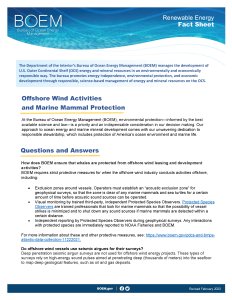
Sounds generated from operating wind turbines are of lower intensity than pile driving but not inconsequential. There are also studies indicating that turbulence generated by offshore wind farms could affect the primary productivity of seasonally stratified waters. This could have significant implications for siting of turbines in areas where right whales forage, such as Southern New England. However, there may be benefits for other species. In at least one area of the North Sea, harbor and grey seals appear to use wind turbine structures to increase foraging opportunities.
Increased vessel activity associated with construction and operation of wind turbines may contribute to disturbance and increase the risk of vessel strikes on marine mammals. Pile driving, anchoring of wind platform structures, and laying of transmission cables has the potential to temporarily or permanently disturb benthic habitat and marine mammal prey species. Cables transmitting energy generated from wind turbines to land-based facilities generate electromagnetic energy, which may be detectable by certain marine species, including marine mammals, but the severity of impacts has yet to be determined.
Sections 101(a)(5)(A) and (D) of the MMPA provide a mechanism for the National Marine Fisheries Service (NMFS) and the U.S. Fish and Wildlife Service (FWS) to authorize the incidental, but not intentional, taking of small numbers of marine mammals by action proponents, such as renewable energy developers. Takes may be authorized provided they would be (1) small in number, (2) have no more than a negligible impact on marine mammals, and (3) have no unmitigable adverse impact on the availability of marine mammals for subsistence uses by Alaska Natives. Take authorizations for renewable energy activities, including wind farm development, typically include a suite of mitigation, monitoring, and reporting measures with which operators must comply to prevent or reduce the adverse effects of those activities on marine mammals.
Mitigation measures to reduce the potential impacts to marine mammals from sound associated with site assessment activities (specifically high resolution geophysical surveys) are similar to those used for seismic surveys and include establishing site-specific exclusion and harassment zones and gradually increasing the sound source to alert marine mammals that may be in the area.
Mitigation measures for impact pile driving may include reducing pile driving power or delaying pile driving if marine mammals approach closely enough to be injured, and prohibiting pile driving during nighttime or low visibility conditions. Additional mitigation measures for pile driving will likely include using sound attenuation devices (e.g., bubble curtains, cofferdams, double-walled shields/piles). Site assessment or pile driving activities may also be prohibited in sensitive areas during specific months.
Support vessels represent an increased risk of vessel strikes, and hence may be required to slow down in certain areas or within set distances from marine mammals. Monitoring and reporting measures for site assessment and pile driving activities would be similar to those required for oil and gas operations.
Mitigation measures that may be most effective in avoiding disturbance of marine mammas include seasonal or temporal restrictions on wind farm site assessment and construction activities, and possibly restrictions on where wind turbines may be located.
The federal leasing process for offshore wind farms is under the jurisdiction of BOEM, which conducts leasing for commercial development of wind energy sites in stages. During the planning stage, states can request that BOEM establish a regional task force comprised of federal, state, and tribal representatives to identify potential lease sale areas that BOEM then uses as the basis for its proposed lease area. Once BOEM identifies a potential lease area, it assesses competitive interest in leasing the area. Alternatively, an applicant can submit an unsolicited lease request. When more than one qualified applicant is interested in competing for a lease, BOEM will hold a lease sale (auction). When only one applicant expresses interest, BOEM will issue the lease non-competitively.
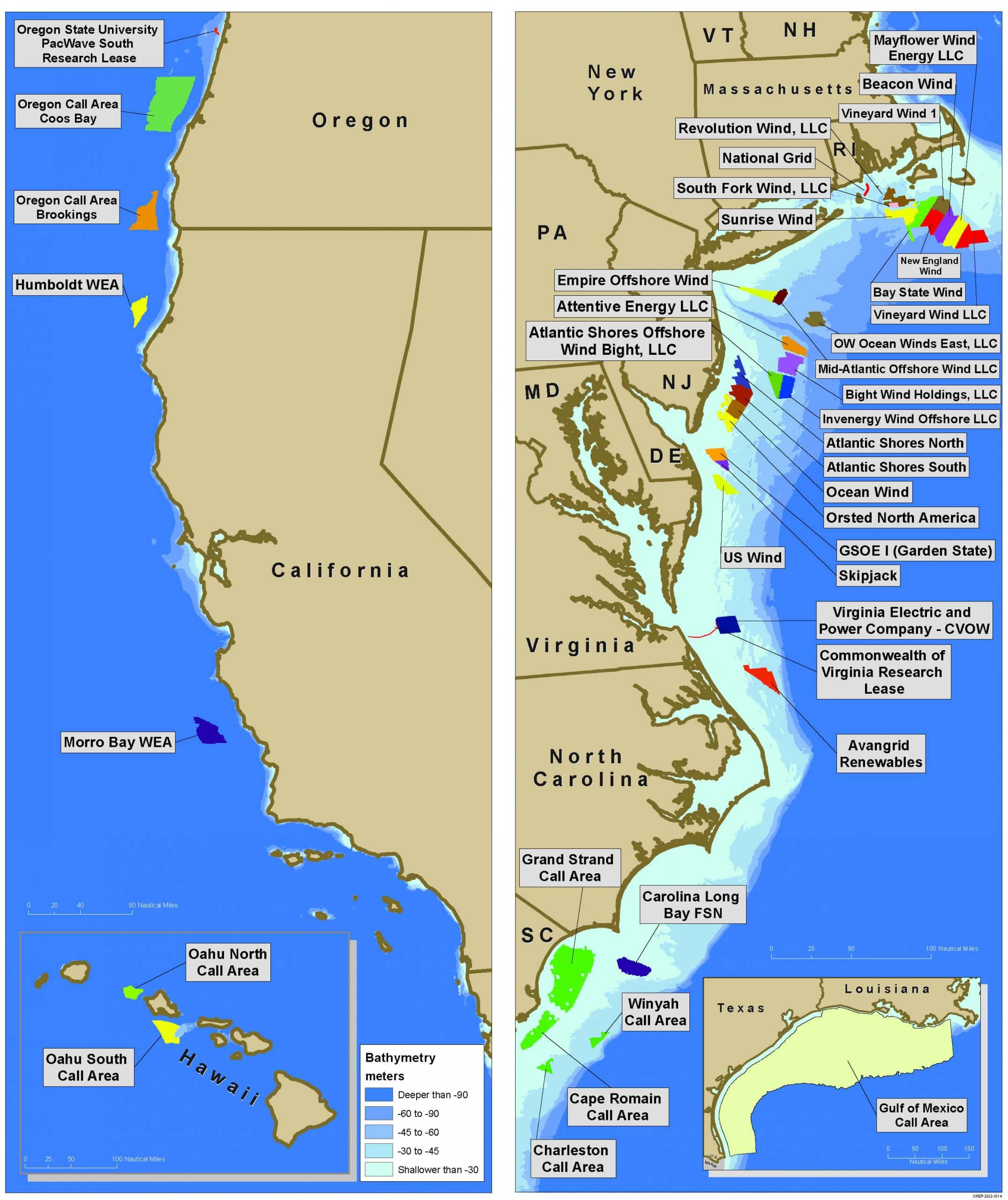
OCS Renewable Energy Lease Areas (Source: BOEM, May 2022)
Once a lease is issued, developers must provide BOEM with a site assessment plan and/or a construction and operation plan within a certain timeframe. Site assessment plans must describe proposed activities to test technologies or assess physical resources and must include relevant data from geological and geophysical surveys, baseline environmental surveys, and archaeological surveys. Once the developers are ready to install wind turbines, they must submit and obtain approval from BOEM for their construction and operation plan, which also must include conceptual plans for decommissioning.
Wind energy development in state waters (generally within three nautical miles of the coastline, with some exceptions) is regulated by individual state agencies and follows state processes. State processes may include the establishment of task forces or other advisory bodies to assist in the identification of potential wind development areas. States also may require baseline studies or the collection of other information needed to determine potential environmental and socioeconomic impacts.
Wind energy developers in state or federal waters undertaking site assessment or construction activities should consult with NMFS and/or FWS regarding the need for a marine mammal incidental take authorization (see above for information on incidental take authorizations and what the Commission is doing).
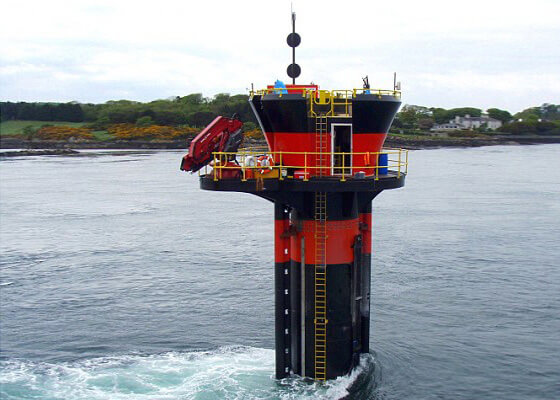
Seagen, the world’s first commercial tidal energy turbine. (BOEM)
Hydrokinetic energy is generated from the movement of water (e.g., tides, waves, and currents). Although only a handful of hydrokinetic operations (most based on tidal energy) are generating reliable energy worldwide, several prototype projects are in use or being tested in the U.S. Pacific.
Tidal energy generators are the most common type of marine hydrokinetic device, primarily because of the predictable nature of tides. Wave energy devices are generally installed at or near the ocean surface and convert energy from the up and down movement of waves rather than the ebb and flow of the tides. Current generators are the least advanced of the hydrokinetic technologies; underwater turbines or water-wheel structures are the most common devices being tested.
The potential impacts of commercial-scale hydrokinetic energy projects on marine mammals and marine ecosystems are poorly known. Impacts are likely to vary based on the design of the hydrokinetic device, its placement in the water column, the presence of moving parts, the anchoring or mooring system, the size of the project, and the species present. If the structure were to be mounted on the seafloor, bottom surveys may be needed to characterize subsurface structure and pile driving may be required to mount the structures, with potential impacts on marine mammals from the sound generated. Underwater turbine foils have the potential to injure marine mammals from collisions with moving parts. Wave attenuators or over-topping devices to capture wave energy may present entanglement or entrapment hazards to marine mammals.
As with wind energy, support activities associated with site characterization, construction, and maintenance of hydrokinetic energy devices may result in an increased risk of vessel strikes, habitat degradation, and impacts on marine mammal prey. In general, more research and monitoring of hydrokinetic devices is needed to address key data gaps and evaluate the potential risk of individual hydrokinetic energy project to marine mammals.
Marine mammal incidental take requirements and associated mitigation, monitoring, and reporting requirements under the MMPA would generally be similar to those for wind energy projects. Measures to prevent interactions, including interactions with underwater turbines, could include deploying acoustic deterrent devices, increasing the underwater visibility of the blades, shielding the turbines, and/or reducing sharp edges. Ideally, such projects would be sited well away from areas inhabited by vulnerable populations. Monitoring should be designed to establish baseline conditions prior to any project activity, using recognized and consistent monitoring methods.
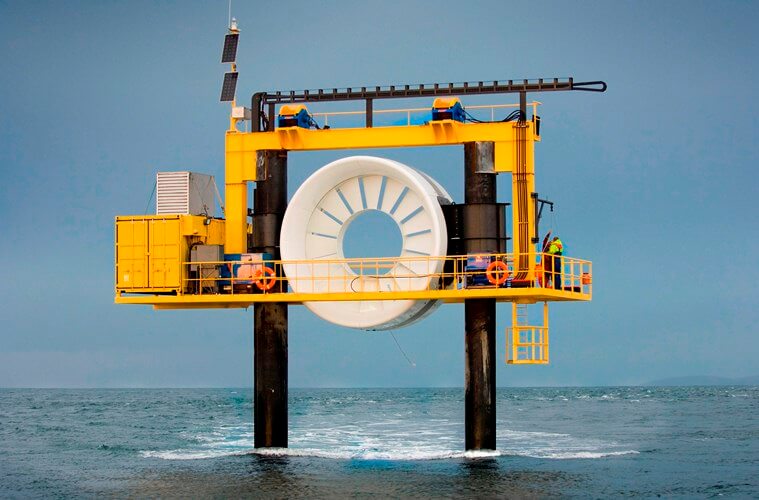
Open hydro system used for harnessing tidal energy. (BOEM)
Leasing of hydrokinetic energy sites is regulated either by BOEM (for federal waters) or individual states (for state waters). BOEM follows the same process for leasing and limited leasing of hydrokinetic sites as for wind energy. Licensing of hydrokinetic energy is under FERC’s authority. BOEM and FERC have issued guidelines on regulation of marine and hydrokinetic energy projects on the OCS to clarify jurisdictional responsibilities for leasing and licensing of those projects. As with wind energy, hydrokinetic energy developers in state or federal waters undertaking site assessment or construction activities should consult with NMFS and/or FWS regarding the need for a marine mammal incidental take authorization (see above for information on incidental take authorizations and what the Commission is doing).
The first drilling for oil in ocean waters took place in 1896, off the coast of California. Since then, offshore drilling has pushed the limits of technology and innovation, with the deepest wells now being drilled in waters more than 1,500 meters deep. Oil and gas represents a significant source of energy as well as revenues, but the development of oil and gas resources can pose considerable impacts on marine mammals and marine environments.
The Commission regularly reviews and comments on Bureau of Ocean Energy Management (BOEM) proposed oil and gas activities and on proposed Marine Mammal Protection Act (MMPA) incidental take authorizations in all U.S. federal waters, also referred to as the U.S. Outer Continental Shelf (OCS). We also comment on and promote environmental studies to better understand the potential effects of oil and gas activities on marine mammals, and facilitate efforts to identify, prioritize, and address information needs through the convening of workshops and meetings.
Commission comments related to federal oil and gas activities on the U.S. OCS are listed below; all Commission comments are available on the Commission’s letters webpage. Commission-sponsored projects and workshops related to offshore energy development and oil spill response are available on the Commission’s workshop reports webpage.
After the 2010 Deepwater Horizon oil spill in the Gulf of America (formerly the Gulf of Mexico), the Department of the Interior (DOI) re-structured responsibilities within the department for the regulation, enforcement, and revenue collections associated with offshore oil and gas development:
The Outer Continental Shelf Lands Act (OCSLA) provides the statutory and regulatory framework for oil and gas development on the U.S. OCS. The Act outlines a four-stage process for oil and gas development.
Section 18 of OCSLA authorizes the Secretary of the Interior, through BOEM, to establish a schedule for oil and gas lease sales for a period of five years, with a mandate to consider environmental and socioeconomic requirements as well as other factors outlined in the law. The development of the 2017-2022 leasing program was initiated by BOEM in June 2014. The Draft Proposed Program was issued in January 2015 followed by the Proposed Program in March 2016 and the Proposed Final Program in November 2016. The leasing schedule included eleven lease sales in four OCS planning areas, including one sale in Cook Inlet and ten area-wide lease sales in the Gulf of America region. Eight of the ten scheduled lease sales in the Gulf were held according to the schedule in the leasing program, but the remaining two lease sales in the Gulf, as well as a scheduled lease sale in Cook Inlet, Alaska, were cancelled by the Biden Administration in May 2022. The Inflation Reduction Act of 2022 reinstated the three cancelled lease sales and put forward a schedule for them to be conducted by the end of 2023.
The current five-year leasing program covers the 2024-2029 time period. The Proposed Final Oil & Gas Leasing Program for 2024-2029 was announced by BOEM on September 29, 2023, and approved by the Secretary of the Interior on December 1, 2023. The 2024-2029 leasing program includes three lease sales in the Gulf of America, scheduled for 2025, 2027, and 2029. The program represented a narrowing of lease sales from the eleven potential lease sales evaluated by BOEM in its Proposed Oil & Gas Leasing Program for 2023-2028 (ten in the Gulf and one in Cook Inlet), and the 47 lease sales evaluated by BOEM in its Draft Proposed Oil & Gas Leasing Program for 2019-2024. The timing of the three lease sales in the 2024-2029 leasing program allows the Administration to meet the requirements of the Inflation Reduction Act of 2022 to hold oil and gas lease sales in the year prior to holding additional lease sales for offshore wind energy development.
President Barack Obama issued several directives related to oil and gas leasing in offshore waters of the United States. In March 2010, the President withdrew Bristol Bay from leasing through 30 June 2017. In December 2014, the President withdrew the entire North Aleutian Basin planning area, which includes Bristol Bay, from all future leasing. In January 2015, the President withdrew certain areas within the Beaufort and Chukchi Sea planning areas in the Arctic from future leasing, including Hanna Shoal within the Chukchi Sea. In December 2016, the President withdrew from oil and gas leasing the Chukchi Sea Planning Area and certain portions of the Beaufort Sea Planning Area, as well as portions of the Bering Sea (the Norton Basin and lease blocks within the St. Matthew-Hall Planning Area lying with 25 nautical miles of St. Lawrence Island). At the same time, the President withdrew from future leasing certain offshore canyon areas of the Atlantic OCS.
On 28 April 2017, President Donald Trump issued Executive Order 13795: Implementing an America-First Offshore Energy Strategy. It encouraged energy exploration and production on the OCS to “maintain the Nation’s position as a global energy leader and foster energy security and resilience for the benefit of the American people, while ensuring that any such activity is safe and environmentally responsible.” As such, the Executive Order directed the Secretary of the Interior to consider revising the schedule of proposed oil and gas lease sales for 2017-2022, including, but not limited to, annual lease sales in the Western and Central Gulf of America, Chukchi Sea, Beaufort Sea, Cook Inlet, Mid-Atlantic, and South Atlantic OCS planning areas, stipulating that any revisions made not hinder or affect ongoing lease sales.
[In response to Executive Order 13795, the Commission submitted comments to BOEM on the development of a new five-year National OCS oil and gas leasing program for 2019-2024, and to NOAA on both the Marine Mammal Acoustic Technical Guidance and the review of National Marine Sanctuaries and Marine National Monuments (see letters section below).]
On 8 September 2020, President Trump signed a Presidential Memorandum that withdrew from leasing consideration, for 10 years (starting on 1 July 2022 and ending 30 June 2032), portions of the eastern and central Gulf currently excluded from leasing under section 104(a) of the Gulf of Mexico Energy Security Act of 2006. The memorandum also excluded from leasing, for the same time period, the South Atlantic and Straits of Florida OCS planning areas. [The memorandum applied to renewable energy as well as oil and gas leasing; however, the Inflation Reduction Act of 2022 authorized the Biden Administration to resume wind energy leasing in those previously withdrawn areas.]
Upon entering office on 20 January 2021, President Joseph Biden signed Executive Order 13990 restoring the withdrawal of certain offshore areas in Arctic waters and the Bering Sea from oil and gas leasing. The President also called for a temporary moratorium on all Federal activities related to the implementation of the Arctic National Wildlife Refuge Coastal Plain oil and gas leasing program. On 27 January 2021, President Biden signed Executive Order 14008, which called for a pause in oil and gas leases on federal lands and offshore waters pending completion of a comprehensive review and reconsideration of federal oil and gas permitting and leasing practices. That Executive Order resulted in BOEM’s subsequent announcement to cancel actions being taken to hold lease sale 258 in federal waters of Cook Inlet, Alaska. BOEM also rescinded its Record of Decision for lease sale 257 in the Gulf , which effectively cancelled the lease sale that was scheduled to take place in March 2021. The pause on oil and gas leasing was lifted by the DOI in August 2021, allowing Lease Sales 257 to go forward while it continued its required review. That review was completed in November 2021, and identified significant shortcomings in the federal oil and gas leasing program, including (1) providing a fair return to American taxpayers and states, (2) designing more responsible leasing processes, and (3) creating a more inclusive and just approach to managing public lands and waters. DOI’s report outlined actions it would take to address the identified shortcomings. The report also encouraged Congress to enact legislation that would provide fundamental reforms to onshore and offshore oil and gas programs. On May 11, 2022, the Biden administration announced that it was cancelling all remaining lease sales in the 2017-2022 leasing program, including one in Cook Inlet, Alaska, and two in the Gulf of America. [As noted above, the Inflation Reduction Act of 2022 reinstated the three cancelled lease sales, directing them to be held by the end of 2023.]
In June 2018, NMFS issued a proposed rule for marine mammal take authorizations related to oil and gas-related geophysical surveys in the Gulf. The proposed rule dealt primarily with seismic surveys used in oil and gas exploration and development, but also included consideration of high-resolution geophysical surveys. The final rule was published by NMFS in January 2021, informed by BOEM’s final programmatic environmental impact statement (FEIS) on geological and geophysical activities in Gulf waters. The final rule allows for the issuance of Letters of Authorization (LOAs) to industry operators for the taking of marine mammals incidental to geophysical surveys, in accordance with prescribed, mitigation, monitoring, and reporting requirements. The final rule is effective from April 2021 to April 2026, and NMFS has since issued LOAs to several geophysical survey companies. In April 2024, NMFS revised the rule governing takes of marine mammal incidental to geophysical surveys in the Gulf to correct errors in the calculation of incidental takes of marine mammals and to incorporate new information.
Oil and gas development in the marine environment proceeds in stages, all of which have the potential to impact marine mammals. For a quick overview, see stages of oil and gas development and potential effects of concern for marine mammals.
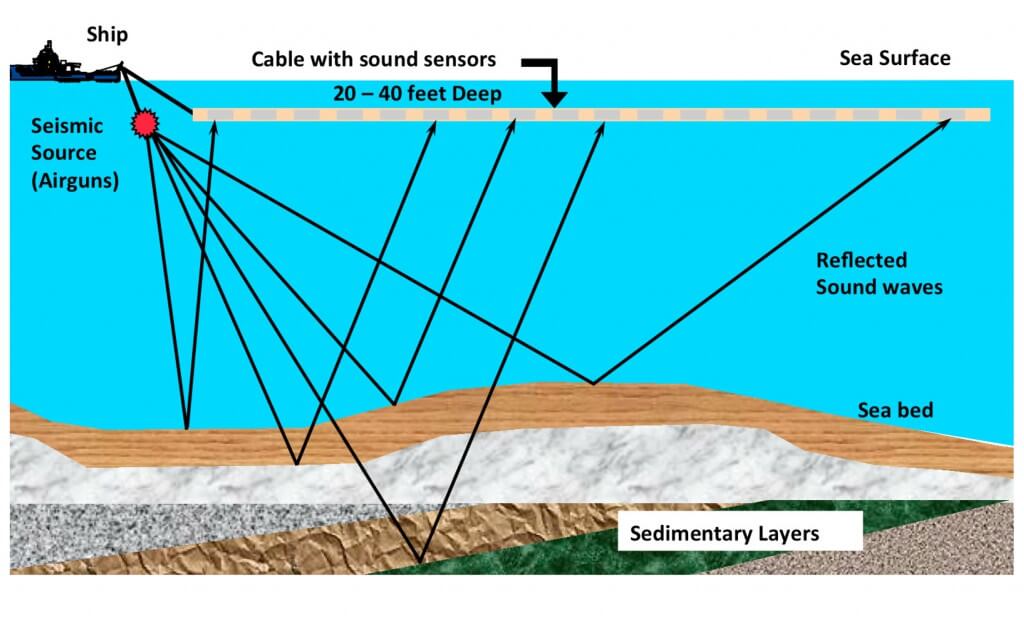
Schematic of offshore seismic survey. (American Petroleum Institute)
Exploration for oil and gas is the process of searching for and characterizing hydrocarbon reserves. The exploration stage involves such geological and geophysical surveys (including seismic surveys, high-resolution geophysical surveys, and gravity and magnetic surveys), sediment sampling, and exploratory drilling. Seismic surveys use a controlled sound source, such as an airgun, to transmit sound waves to the ocean floor. The pattern of reflected waves reveal subsurface features that can indicate the presence of hydrocarbons. Seismic surveys can vary in sound intensity and in the amount of geographic area covered. In general, 2-D seismic surveys are used to collect seismic data over a broad area, 3-D surveys are used to collect a larger set of measurements over a smaller area, and 4-D (or time lapse) surveys are used to collect dense measurements in the same small area repeatedly over time. Wide-azimuth seismic surveys collect geophysical data from many different angles, and are used primarily in the Gulf to investigate oil trapped below salt domes and other subsurface structures.
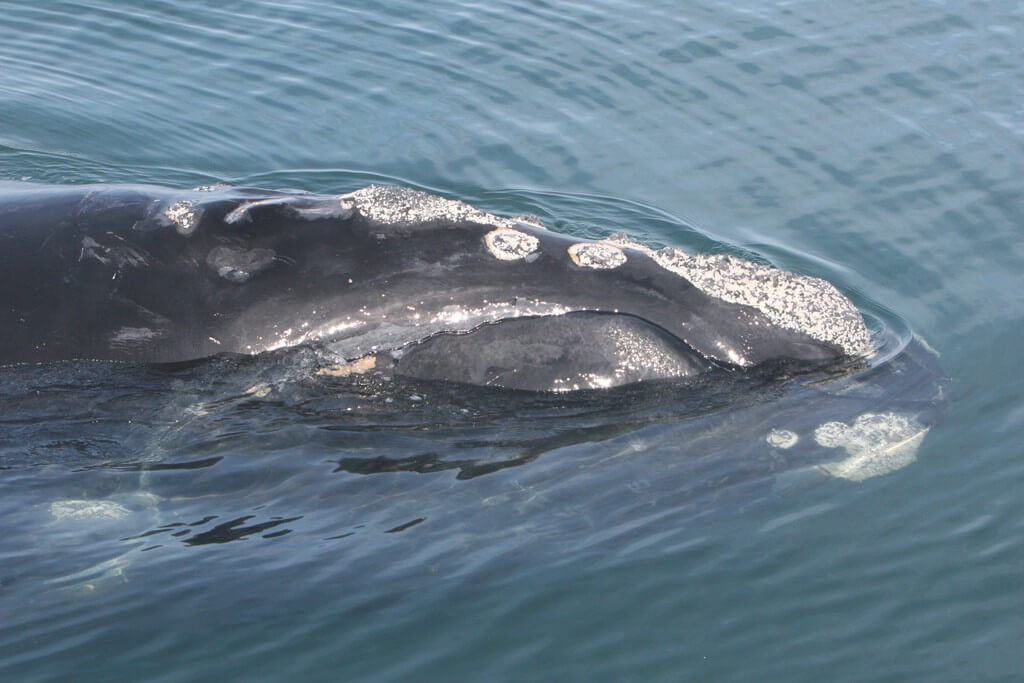
North Atlantic right whale off the coast of Florida. Photo taken under NOAA research permit #775-1875. (Florida Fish and Wildlife Conservation Commission)
Seismic airguns emit high energy, low-frequency impulsive sound that travels long distances. Marine mammal response to seismic surveys can cause disruption of important marine mammal behaviors, and—at close range—physiological injury. Sound from airguns can also mask biologically important sounds, including communication calls between individuals of the same species. Baleen whales (e.g., North Atlantic right whales) are believed to be affected by seismic survey activity because of their sensitivity to low-frequency sounds. However, other cetaceans may also be affected, notably harbor porpoises and beaked whales.
Once seismic surveys are completed, exploratory drilling is used to confirm the presence of hydrocarbon reserves and to make decisions regarding the economic feasibility of developing an oil and gas field. Exploratory drilling in offshore waters generally involves a single well and can occur over weeks, months, or even years, depending on the depth of the well and other geophysical features, weather, availability of equipment or personnel, safety concerns, or other issues. After exploratory drilling has ceased, wells are capped and abandoned either temporarily or permanently.
Exploratory drilling may impact marine mammals based on disturbance by sound emitted during drilling, during seismic profiling of the well, and from support vessels or aircraft. Drilling can also result in oil spills, which can affect marine mammals directly by contact, inhalation, or ingestion, or indirectly by affecting marine mammal prey or habitat. For a more thorough discussion of the potential effects of an oil spill on marine mammals, see our Deepwater Horizon Oil Spill page.
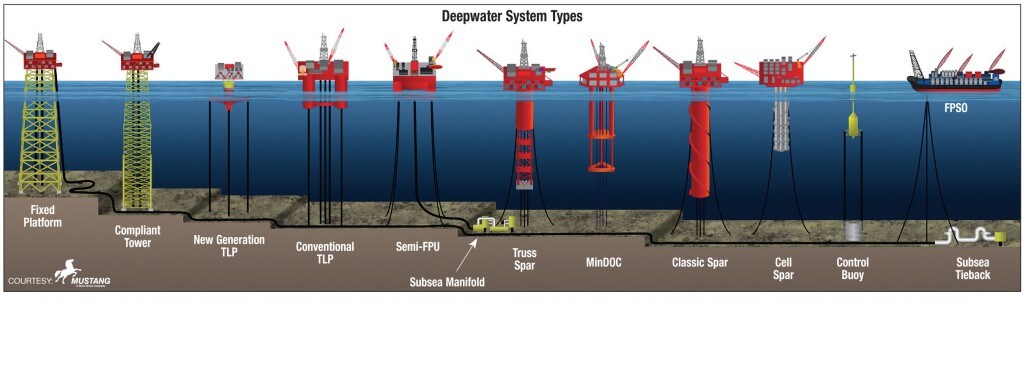
Types of deepwater oil drilling rigs. (Used with permission from 2011 Deepwater Solutions for Concept Selection poster, Wood Group Mustang and Offshore Magazine)
If suitable oil and gas reserves are found, the next stage of development involves construction and installation of drilling platforms or structures and transport systems (e.g., pipelines). Construction begins with site surveys and planning, which can involve high-resolution geophysical surveys and result in sound-related effects. Impact pile driving during construction of shallow-water platforms also can be a significant source of low-frequency sound. Both shallow- and deep-water construction can require aircraft and vessel activity, which can cause marine mammals to avoid or move away from preferred habitat and increase the risk of ship strikes. The construction and anchoring of infrastructure and equipment can alter or degrade bottom habitat, which can affect the distribution of marine mammal prey. If oil or gas is to be transported by pipeline, either buried or on the seafloor, more construction activity is required and therefore more sound would be emitted and seabed disturbance can result. Finally, all of these activities may increase the amount of debris in surrounding waters and thus increase ingestion hazards for marine mammals.
The production stage involves the drilling of one or more wells, extraction of oil and gas, and transport of the oil to refineries and the gas to markets, either through pipelines or in tankers. Depending on the size of the reservoir and the recovery rate, an oil and gas platform may be productive for several decades or longer. Seismic surveys may be conducted on a regular basis to guide drilling activities and monitor changes within the reservoir and the pipeline. Both drilling and seismic activities generate sound that may be harmful to marine mammals. Vessel and aircraft activity is a source of chronic disturbance and vessel activity can increase the potential for ship strikes and fuel spills. Drilling produces muds and cuttings that may be discharged near the well site, injected back into the ground, or collected and disposed of off-site. Certain types of muds and cuttings can introduce heavy metals and other toxic materials into the marine ecosystem. If produced oil is to be transported by vessel, mooring systems may be required with associated anchoring and potential disturbance of seafloor habitat.
When economic conditions and conditions within the well reservoir indicate that oil and gas production is no longer warranted, well production is discontinued and the platform and associated infrastructure are decommissioned. This stage of development can result in disturbance of sediment and the discharge of metals associated with the severance, removal, toppling, and/or destruction of platforms, wellheads, cables, and other equipment and structures. Decommissioning can involve various types of non-explosive cutter tools, but a variety of explosives can also be used to remove underwater structures. Both non-explosive and explosive methods can introduce significant sound into the marine environment, which may be harmful to marine mammals and their prey. Abandoned wells also have the potential to leak oil and gas. Under certain circumstances, platforms (or portions of them) may be left in place, where they serve as artificial reefs.
Spills and leaks can occur at all stages of oil and gas development, with varying effects based on the type and amount of substance spilled. Large spills (defined as > 1,000 barrels) can occur from blowouts, other losses of well control, or accidents during loading, transport, and unloading of oil or gas from platforms to shore via vessels or pipelines. Smaller spills and leaks of oil, gas, or other chemicals also can occur from storage tank accidents, transfer mishaps, leaks from fuel tanks, or incidents involving temporarily or permanently abandoned wells. Spills and leaks can cause acute injury or mortality, can have longer-term, sublethal effects on marine mammals, and can degrade habitat.
The Bureau of Safety and Environmental Enforcement (BSEE) is responsible for the promotion of safety and protection of the environment through regulatory oversight and enforcement of regulations governing the oil and gas industry. In 2016, BSEE proposed significant new regulatory safeguards for well control and blowout preventer systems to prevent oil spills based on lessons learned from the Deepwater Horizon oil spill. BSEE also issued new drilling rules for the Arctic. BSEE revised and weakened the regulations for well control and blowout preventer systems in May 2019 in an effort to reduce unnecessary burdens on oil and gas companies. BSEE also proposed revisions to weaken the Arctic drilling rule in 2020, but withdrew the proposed revisions in June 2021.
Response efforts to contain and clean up oil spills also have the potential to affect marine mammals through increased sound from vessel traffic as well as increased risk of ship strikes. During the Deepwater Horizon oil spill chemical dispersants were used both at the surface and at depth to disperse oil. Although research on the effects of dispersants increased after the spill, information about those effects on marine mammals is lacking. The use of booms and skimmers to contain and collect surface oil and the burning of oil on the water surface are activities that also have the potential to disturb marine mammals. Burning reduces the overall amount of oil in the marine environment. However, burning also leaves behind a residue of uncertain composition and toxicity, puts additional chemicals into the air, and can kill animals such as sea turtles that get caught in the fires. An investigation into the state of the science regarding the use of dispersants in Arctic waters was conducted by the University of New Hampshire’s Coastal Response Research Center and Center for Spills and Environmental Hazards, with a series of reports published on topics covering efficacy and effectiveness, physical transport and chemical behavior, degradation and fate, eco-toxicity and sub-lethal impacts, and public health and food safety.
Sections 101(a)(5)(A) and (D) of the MMPA provide a mechanism for NMFS and the U.S. Fish and Wildlife Service (FWS) to authorize the incidental, but not intentional, taking of small numbers of marine mammals by oil and gas companies or seismic operators. Takes may be authorized provided they would be (1) small in number, (2) have no more than a negligible impact on marine mammals, and (3) have no unmitigable adverse impact on the availability of marine mammals for subsistence uses by Indians, Aleuts, or Eskimos who reside in Alaska (Alaska Natives). Take authorizations for oil and gas activities typically include a suite of mitigation, monitoring, and reporting measures with which operators must comply to prevent or reduce the adverse impacts of oil and gas development on marine mammals.
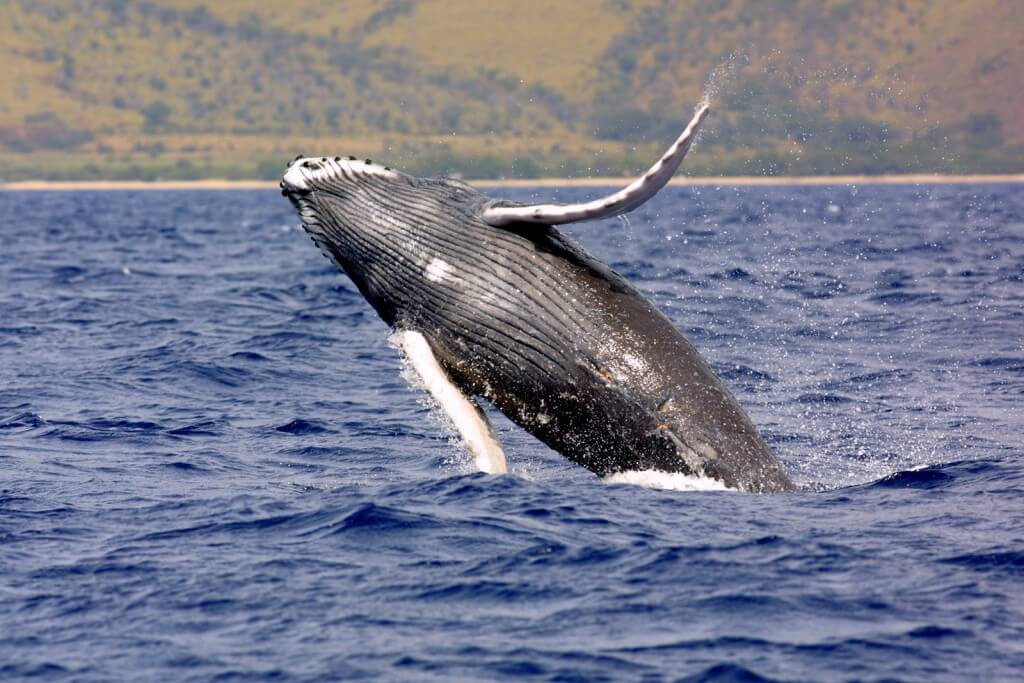
Many cetaceans may be affected by seismic oil and gas exploration including humpback whales, killer whales, sperm whales, and short-finned pilot whales, which use low frequency sounds in their daily lives. (NOAA)
Mitigation measures for seismic or other sound-generating activities may include ensuring the area is clear of marine mammals prior to the start of operations, gradually increasing the intensity of the sound source to alert marine mammals that may be in the area so that they can move away, shutting down the sound source if marine mammals approach close enough to be injured, and prohibiting operations at night or during low-visibility conditions. To minimize the probability of vessel strikes, vessels may be required to slow down within a certain distance of marine mammals. Aircraft operating in an area may be required to fly above a certain altitude to avoid disturbing marine mammals. Proposed activities also may be prohibited in sensitive areas at specific times (such as during calving, breeding, feeding, or resting, or during subsistence hunting in Alaska). General and site-specific mitigation measures are based, to the extent possible, on observations of animals exposed to various industrial activities and the animal’s hearing abilities and behavioral response. Nevertheless, the effectiveness of many mitigation measures has yet to be determined.
Alternatives to seismic airguns include the use of marine vibroseis (which is typically used on shore), deep-towed acoustics/geophysics systems, low-frequency passive acoustic systems, and controlled source electromagnetic systems. Some have the potential to replace seismic airguns for offshore surveys, but all are still in various stages of development or testing and not yet commercially available. Modeling to compare the effects on marine mammals from sounds produced by marine vibroseis and seismic air guns predicted that, in general, fewer marine mammals would be affected by marine vibroseis than air gun arrays.
Monitoring for the presence of marine mammals in areas around and potentially affected by oil and gas activities serves two main functions. First, monitoring is necessary to implement mitigation measures, such as a shut-down of the sound source. Second, monitoring should document the effects of an activity, including the number of marine mammals taken and the type of taking. Such information is useful for evaluating the effectiveness of mitigation measures and refining or developing such measures for future activities.
Marine mammal sightings must be documented and reported to the agency that issued the incidental take authorization, both during an activity and at its completion. Immediate reporting of a dead or seriously injured marine mammal is also required, with immediate suspension of operations generally required if the death or injury might have been caused by that activity.
Learn more about the history of oil and gas development in the U.S. OCS.